As I wind down the business toward full retirement, I am selling my remaining potted Epimediums at a couple of off-site, in-person, specialty plant sales and at my talks during the growing season. I am no longer shipping plants. You can find a list of other mail order sources that do ship epimediums here.
The following plants described here are those that we have sold since the business started in 1997. They are listed here mostly for informational purposes. Many of the mail order sources that I list have been customers over the years, so they carry some of the same species/varieties. I will have some of these plants available at my off-site sales in 2023. If you are interested in a particular plant, email me well before the event and I will let you know if I have it available to bring to the sale.
As you scroll through, click on the photo for a description of each plant. If Epimediums are new to you, I suggest that you familiarize yourself with them first in the About Epimediums section listed on the Home page. This is especially important if you will be growing them in one of the more extreme climates zones in the U.S. (such as zones 3-4 or 8-9). To view and sort plants by “Species,” “Color,” or “Growth & Habit (which includes lists of types to try under more extreme conditions of cold, heat or drought),” please click on “Find Plants” from the header menu on the home page.
Photos are taken by Karen Perkins or Darrell Probst unless otherwise credited. All photos copyright Garden Vision Epimediums.
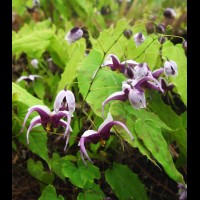 Epimedium acuminatum
Epimedium acuminatum
This species was originally collected by Mikinori Ogisu in the late 1970’s, and first introduced into the U.S in 1982. Several new introductions have arrived since, but this clone is the most dwarf at 8-10”. Relatively small evergreen leaflets, bright green in spring with shadows of purple flecks. The large flowers have white inner-sepals and grape-purple petals/spurs. Foliage 8-10" high at maturity.
This drought tolerant spreading species from southern Europe sports very small flowers held below and among medium-sized leaflets. Inner-sepals are red behind creamy-yellow petals/spurs. 12" tall. The leaflets flaunt a complementary thin, mascara-like red edge while the plant is in bloom. Spreads 8-12" a year, forming an open groundcover. Semi-evergreen.
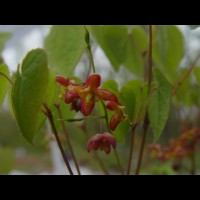 Epimedium alpinum 'Shrimp Girl'
Epimedium alpinum 'Shrimp Girl'
The clone ‘Shrimp Girl’ is shorter in height (6-8”) than E. alpinum with shorter rhizomes; spreading only 4-5” a year. Its dense growth habit and thick foliage make it far supe
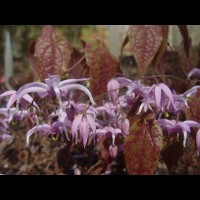 Epimedium brachyrrhizum
Epimedium brachyrrhizum
Discovered in 1994 in Guizhou Province, China, it is one of the shortest species at only 6-8" tall, and among the largest flowered and earliest to bloom, with lavender-pink flowers nearly 2" across! New leaflets may be handsomely mottled with red-maroon in spring. Dark evergreen leaflets have a distinct corrugated surface, and many clones take on maroon overtones in fall. Not available this year.
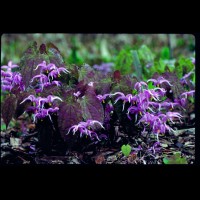 Epimedium brachyrrhizum 'Karen'
Epimedium brachyrrhizum 'Karen'
After years of trialing this plant against other superior forms of E. brachyrrhizum this stands out as the best for its prolific, large flowers in a soft shade of lavender-pink, combined with large leaves, heavily mottled with deep cranberry-rose in the spring. E. brachyrrhizum just happens to be one of my favorite Epimediums, so Darrell named this outstanding clone in my honor. 7” tall. Evergreen.
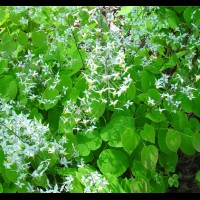 Epimedium brevicornu
Epimedium brevicornu
A beautiful hardy, deciduous species native to the northern regions in China where Epimediums are not normally found. These are divisions from plants collected during Darrell’s 2001 expedition to Henan Province where no Epimediums had been previously recorded. Produces an 8 to 10” high mass of small, rather round, heart-shaped leaflets. Numerous 10” long spikes carry “clouds” of small, star-shaped white flowers, each with short, reflexed spurs with a hint of yellow in the center. New leaflets may be speckled with reddish-purple and are thin and reminiscent of parchment paper to the touch. Hardy to Zone 4 and perhaps even 3! Early and long blooming, sometime for up to a month! $22
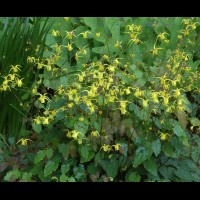 Epimedium davidii 'Emerald Sheen'
Epimedium davidii 'Emerald Sheen'
***2008 Cobblewood™ Introduction***
Extremely glossy leaflets are what makes this clone spectacular. It forms a mass of low growing, shiny foliage with smaller than normal, evergreen leaflets. The new spring foliage is tinted maroon. Flower stems are 12-24” tall with long spikes of many large, rich yellow flowers with tiny red inner-sepals. It is clump-forming, but produces occasional 3–5” rhizomes. Excellent for breeding, in that it passes the sheen of its foliage along to its offspring.
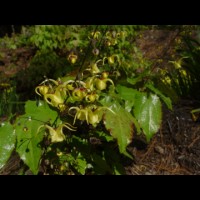 Epimedium davidii "Robust Forms"
Epimedium davidii "Robust Forms"
Like many species, E. davidii varies from one location to another. In 1999 Darrell helped to identify Epimediums purchased from China by a local nursery. Overall they were more robust and vigorous than any of the clones that he had collected in China, with flower stems from 18-24” high bearing the typical bright yellow blooms. They also had bolder evergreen foliage than any we have grown. The clones we offer have attractively red-mottled spring leaflets. Spreads slowly by occa
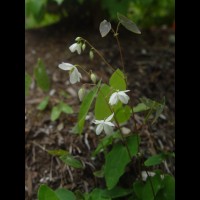 Epimedium diphyllum Cc. 940545
Epimedium diphyllum Cc. 940545
Only 5 to 10" tall in bloom, produces dainty, spur-less white, bell-shaped flowers over an extended period in spring for a very delicate effect. One of several clones imported from Japan. Semi-evergreen. Not available this year.
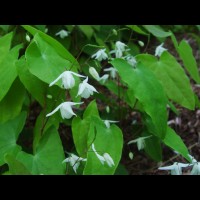 Epimedium diphyllum "Large Leaf Form"
Epimedium diphyllum "Large Leaf Form"
With the largest plant habit of E. diphyllum by far, its bolder leaflets are upwards of 4” long, 1-1/2” wide. White flowers slightly larger than other clones, on stems 10-12” tall. Semi-evergreen.
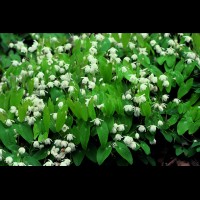 Epimedium diphyllum 'Nanum'
Epimedium diphyllum 'Nanum'
A sparkling gem at only 2-4" tall at first bloom, and covered in white bell-shaped flowers. Ultimately reaches 8" high. Ideal for shady rock gardens, path edges or troughs.
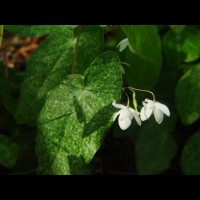 Epimedium diphyllum 'Variegatum'
Epimedium diphyllum 'Variegatum'
(Synonyms: 'Shiro tiri fu', 'Shiro chiri fu')
Friends Roy Herold and the late Gerry Anderson bought this plant back from Japan for Darrell in 1995. The leaflets are variously stippled—some leaves are green with flecks of white, others white flecked green. The white variegation is enhanced with 2-3 hours of direct daily sun in our nursery. Dainty white flowers hover above leaves reminiscent of small spattered painter’s palettes. Foliage gradually turns greener through the season, but the variegation is still evident in the fall as the foliage turns to rusty red. 12" tall.
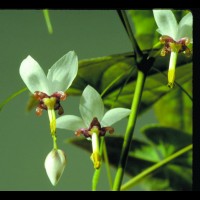 Epimedium dolichostemon
Epimedium dolichostemon
Narrow, evergreen, medium-sized arrow-shaped leaflets, heavily mottled with burgundy in the spring. Each small uniquely shaped flower has beautiful, reflexed, white inner-sepals and red petals with short, strongly curved spurs. 18” tall. In 1998, Robin White generously shared a blooming plant.
Darrell was awestruck the first time he saw slides of this clone. Lois Himes, garden assistant to Harold Epstein, took them of a plant exhibited by Robin White when she accompanied Harold to a 1995 Royal Horticultural Society show in London. It is far superior to the Ogisu clone (Og. 81011-- which is unfortunately terribly virused) making the rounds in the U.S.
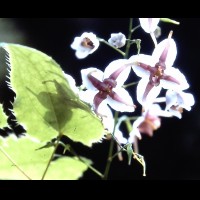 Epimedium epsteinii
Epimedium epsteinii
Discovered in 1994 and named after an outstanding plantsman—the late Harold Epstein. For half a century he grew Epimediums to perfection in his garden “La Rocaille” in Larchmont, NY.
This species has the widest sepals in the genus, nearly 1/2" across and slightly longer, pure white and a striking contrast to the reddish-purple spurs and cup. There are 10 (usually) to 30 of these medium-large flowers per stem. 6-10" tall with medium-sized, dark glossy evergreen leaflets. Spreads 6-8" a year forming a dense low ground
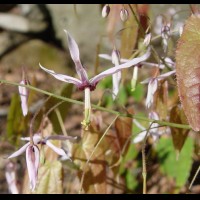 Epimedium fargesii
Epimedium fargesii
The typical forms of a very choice species and the main target of Darrell’s November 2000 collecting trip to China. He gathered small divisions from a variety of plants at seven locations. 12-18” tall in bloom, with narrow, medium-sized arrow-shaped, dark evergreen leaflets, that persist in the winter garden.
The medium-sized flowers typically have long, white/pale lavender inner-sepals that wrap around smaller, lavender spurs. Often both reflex backwards. Foliage exhibits dark maroon flecking in spring and sometimes fall. First flush 8-10", second growth flush to 15".
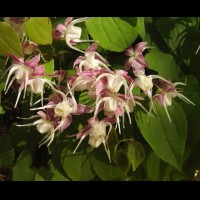 Epimedium grandiflorum
Epimedium grandiflorum
The typical form of the species in the U.S., with rosy inner-sepals, and creamy-white spurs and cup. The small new spring leaflets have a brown-purple cast to them that nicely complements the flower color. 7" tall in bloom, with a second growth flush to 14".
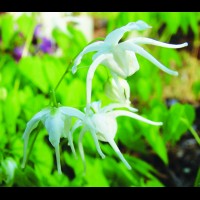 Epimedium grandiflorum 'Album'
Epimedium grandiflorum 'Album'
A favorite of Darrell's since the first time he saw it in Harold Epstein’s garden, as it really stands out, very fresh and bright in the spring. Originally imported from Japan, it has large, pristine white flowers sus
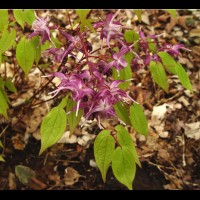 Epimedium grandiflorum 'Benedict's Violet'
Epimedium grandiflorum 'Benedict's Violet'
This seedling originated in Dr. Herb Benedict’s garden in Hillsdale, MI. Large, reddish-grape flowers hover over young spring green leaflets with a rosy edge. 9” tall with no second growth flush. Very floriferous. A shorter Epimedium that quickly forms a clump.
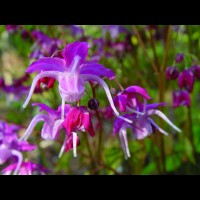 Epimedium grandiflorum 'Bicolor Giant'
Epimedium grandiflorum 'Bicolor Giant'
Bold, cheerful and bright flowers and later the large leaves both make a nice show from a distance. The large flowers exhibit in-curved sugary pink spurs under wide, deep raspberry sepals. The flowers bloom from underneath the leaves, but are produced in such profusion, that they are showy nonetheless.
After bloom, the large new spring leaflets blush with red before turning to their summer green. Another giant red similar to ‘Red Queen’ and ‘Orion’, but with a bi-colored bloom. Acquired in from Gotemba Nursery, Japan in 1997 as a “pink grandiflorum”. 16” tall in flower. It has exhibited yellow, rusty orange and maroon fall colors here in Massachusetts. Forms a substantial clump that reads as a small shrub in the perennial border.
***2006 Cobblewood Introduction***
Beautiful large rose-red flowers accented with white spur tips have caught the eye of many a visitor to our open nursery weekends. This cultivar has much the same characteristics to recommend it as Epimedium grandiflorum ‘Yubae’ but with 2-3 times the number of bloom stems held above the foliage, and a shorter stature. Heavily flowered with a slightly darker cast to the young foliage. Medium-sized leaflets form a mound to 13”. An early bloomer hybridized by Darrel Probst.
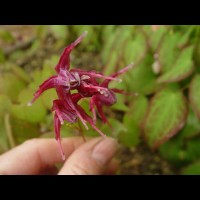 Epimedium grandiflorum 'Cranberry Sparkle'
Epimedium grandiflorum 'Cranberry Sparkle'
***2002 Cobblewood™ Introduction***
Darrell’s friend Don Elick spent five days in April 1995 on a whirlwind dash through southern Japan searching for select forms of wild Epimediums that might prove useful in Darrell’s breeding program. This was his most incredible find with large, rich cranberry flowers held out horizontally on 6” stems. The small leaflets are flushed bronze in spring. Very, very late to emerge and one of the last grandiflorums to bloom. 10” tall.
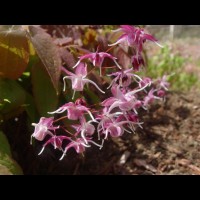 Epimedium grandiflorum 'Dark Beauty'
Epimedium grandiflorum 'Dark Beauty'
Harold Epstein admired this plant for its velvety, deep chocolate-purple new spring foliage. It appeared as a seedling in his garden from an apparent cross between ‘Yubae’ and ‘Silver Queen’. Its large flowers have beautiful dark rose inner-sepals and white petals/spurs flushed with rose. Small leaflets. 8” in bloom with second flush to 12”. A strong grower and one of the first “Eps” to emerge and bloom each year in the nursery.
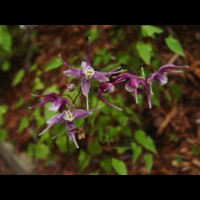 Epimedium grandiflorum 'First Kiss'
Epimedium grandiflorum 'First Kiss'
One of the smallest grandiflorums. Large flowers are produced just above the first set of leaves at only 4” tall. Dark lavender-rose flowers have white accents on the rim of the cup and the spur tips. Small spring leaflets are flushed purple. Second flush to 9”. Its short stature makes it great for troughs or the front of the shade border.
 Epimedium grandiflorum 'French Braid'
Epimedium grandiflorum 'French Braid'
***2007 Cobblewood Introduction***
This eye-catching, vigorous, bold-foliaged seedling from Harold Epstein’s garden stands out from the pack with its bright, almost tropical spring leaf coloration. A psychedelic shade of orange flushes the edge of the leaflets that are dissected by luminous chartreuse veins flowing into an all green center. Large, elongated, overlapping leaflets tumble downward in a zig-zag pattern. Large creamy white flowers are borne underneath the expanding leaflets. 14” in bloom.
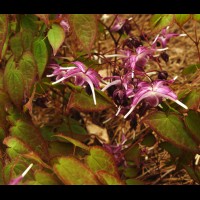 Epimedium grandiflorum 'Lavender Lady'
Epimedium grandiflorum 'Lavender Lady'
***2000 Cobblewood Introduction***
This beauty appeared as a seedling in Harold’s garden as a cross between E. sempervirens ‘Violet Queen’ and E. grandiflorum ‘Silver Queen’. Its red leaf color comes from the former and its numerous leaflets from the latter. It forms a mass of wide-spreading, low-growing leaves composed of medium-sized leaflets, their edges suffused with a deep red that fades into a soft green, netted center. This beautiful mass of foliage is topped by full panicles of large, lavender flowers with white spur tips. 8” tall in bloom. No second growth flush. Striking reddish-orange fall color. Early bloomer with a distinctly horizontal growth habit. Semi-evergreen.
 Epimedium grandiflorum 'Lilac Seedling'
Epimedium grandiflorum 'Lilac Seedling'
Friend Teyl de Bordes of Scotland selected this outstanding seedling from a batch at Washfield Nursery. Medium-large, arrow-shaped leaflets emerge a spectacular deep reddish-purple in spring etched in bright green along the main veins. The color remains for about a month before turning green. 12-18” tall. Dense heads of large light lavender and white flowers are produced below the new leaves. Very showy.
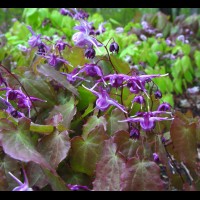 E. grandiflorum 'Lilafee'
E. grandiflorum 'Lilafee'
A popular favorite for its large, delicate, violet-purple flowers with white spur tips held above small, purple-tinted spring leaflets. Reaches 8” tall in bloom with a second flush to 14” tall.
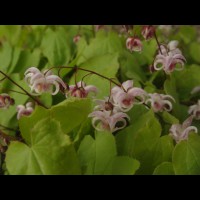 Epimedium grandiflorum 'Mizuhomaru'
Epimedium grandiflorum 'Mizuhomaru'
(Synonym: ‘Sakaru Moru’)
A curious Japanese cultivar with spurs that curve sharply inward towards the cup in cold temperatures. This unique flower form makes it a popular choice when seen in bloom at our on-site nursery sales. Medium-sized, pale lavender-purple flowers. Small leaflets. 8” tall in bloom; second growth flush to 12”. Leaves sometimes turn shrimp pink in the fall.
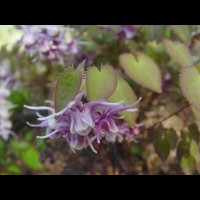 Epimedium grandiflorum 'Mt. Kitadake Purple'
Epimedium grandiflorum 'Mt. Kitadake Purple'
Large, intensely rose-violet flowers are held above richly colored foliage. White highlights along the outer edges of the flower resemble crisp white piping. The muted red tones of the early spring foliage later fade to a rosy band at each leaf edge, encircling a light green center with a slight rose blush. The small leaflets are fringed with long white spines, likened to white eyelashes by one of my more enthusiastic customers! 6-7” in bloom, second flush to 10”.
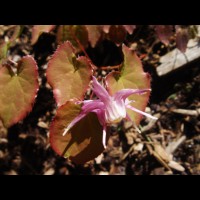 Epimedium grandiflorum 'Mt. Kitadake Red'
Epimedium grandiflorum 'Mt. Kitadake Red'
A darling little plant, beginning its bloom with leaves only 5” tall. The large, rose-red flowers are held above the foliage at 7” high. A second flush of leaflets follows on stems to 10”. Each small leaflet is tinted with bronze to dark reddish-purple in spring. This clone has exhibited pink and yellow fall color in the nursery.
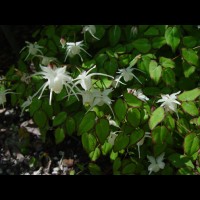 Epimedium grandiflorum 'Nanum'
Epimedium grandiflorum 'Nanum'
Perfect for a shady trough garden or border edge at only 3-5” in bloom. Second growth flush of foliage later reaches 10” in height. Medium-sized white flowers are in proportion to the size of the plant as are the tiny, rounded spring leaflets, each with a light purple band around their edge in spring. Particularly late to emerge in spring.
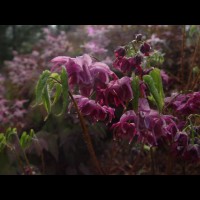 Epimedium grandiflorum 'Orion'
Epimedium grandiflorum 'Orion'
A giant “red" flowered Epimedium, probably originating from central Honshu in Japan. Grows 14 to 18” tall at bloom time, with large leaflets, and no sec
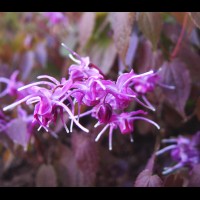 Epimedium grandiflorum 'Pierre's Purple'
Epimedium grandiflorum 'Pierre's Purple'
***1999 Cobblewood Introduction***
Named for Pierre Bennerup of Sunny Border Nurseries who originally shared it with Darrell. 7” tall in bloom, with a second growth flush to 15”. Beautiful, large, rich wine-purple flowers with white spur tips are borne against small leaflets flushed bronze in early spring. The intense spring color of the leaflets elicits many comments during our bloom season, but gradually fades as the flowers age. Leaflets turn a limey green in mid-autumn.
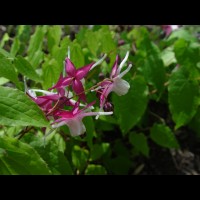 Epimedium grandiflorum 'Princess Susan'
Epimedium grandiflorum 'Princess Susan'
***1999 Cobblewood Introduction***
A beautiful, large-flowered selection from Harold Epstein’s garden, named after his daughter. Flowers are a crisp contrast of cherry-rose inner-sepals and pure white petals/spurs against small, bright green leaflets. Foliage grows more horizontally than that of other Epimediums. 8” in bloom with a second growth flush to 13”. A late bloomer.
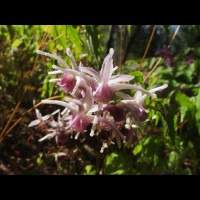 Epimedium grandiflorum 'Pseudo Larchmont'
Epimedium grandiflorum 'Pseudo Larchmont'
***1998 Cobblewood Introduction***
This unusually large, floriferous clone bears masses of creamy-lavender and purple blossoms with arching spurs that billow out from under the edges of the foliage. As a rule, it produces only 9 leaflets per leaf, instead of up to 15, giving bolder texture. The leaflets are dark green, narrow, and distinctively angular in shape. A strong grower, ‘Pseudo-Larchmont’ grows to 8” in bloom, with a second growth flush to 20+”.
 Epimedium grandiflorum 'Purple Prince'
Epimedium grandiflorum 'Purple Prince'
The richest, deepest purple form of E. grandiflorum that we’ve ever seen. Visitors often remark at its exceptional beauty, even in bud. Spring leaves emerge a muted rose. 8” tall in bloom, with a second flush to 18”. Small leaflets, medium-sized flowers. An early bloomer.
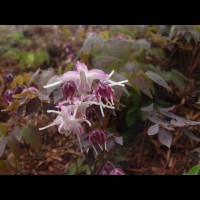 Epimedium grandiflorum 'Queen Esta'
Epimedium grandiflorum 'Queen Esta'
A beautiful cultivar named by Harold Epstein after his wife, Esta. It was the first named seedling ever introduced from his garden. Notable for its large flowers with dark lavender inner-sepals and pale lavender spurs held against the chocolate-brown new spring foliage. It grows 6-8” tall in bloom, with a second flush of new dark leaves to 12”. Small leaflets. One of the earliest E. grandiflorums to bloom in spring.
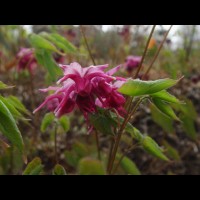 Epimedium grandiflorum 'Red Queen'
Epimedium grandiflorum 'Red Queen'
Harold Epstein bought this imposing plant in Japan many years ago, and nicknamed it “Red Queen”. As far as we can determine, it was not a named cultivar. Large, vivid, rose-red flowers peek out from under huge leaflets that may grow to 6” long/4” wide. The bold fall foliage of this regal Epimedium sometimes turns shades of pink/orange. A second growth flush of red-tinted foliage reaches to 14”. A vigorous, bold-textured choice that makes a substantial clump over time.
Ozzie Johnson of Marietta, GA brought back this striking cultivar from Japan. It produces masses of delicate 1” pristine white flowers with long, thin, elegant and prominently curved spidery spurs above a bun of medium-sized, bright apple-green leaflets at only 5” tall. Crisp and clean look to flowers and foliage. Second growth flush to 14”.
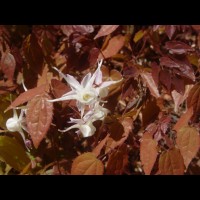 Epimedium grandiflorum 'Silver Queen'
Epimedium grandiflorum 'Silver Queen'
Very textural with leaves usually divided into 27 small leaflets that are mahogany-flushed in spring. The large white flowers have "silvery-lavender" highlights on the inner-sepals. 7" tall in bloom, second flush to 11". A parent of many cultivars. An early bloomer.
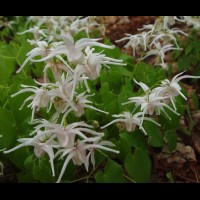 Epimedium grandiflorum 'Sirius'
Epimedium grandiflorum 'Sirius'
A 1990 Dick Weaver introduction, ‘Sirius’ originated as a seedling in Harold Epstein’s garden. The large and delicate palest of pink flowers float above small, distinctively light green leaflets. Often only 5” tall in bloom, with a second flush of growth to 10”. Blooms at the "tale-end" of the Epimedium season.
 Epimedium grandiflorum 'Spring Wedding'
Epimedium grandiflorum 'Spring Wedding'
2003 Cobblewood Introduction
The fresh spring foliage of this selection emerges dark purple, then lightens and expands to display a bold, 1/4” wide, mahogany-red edge. Very floriferous, it produces numerous flower stems held well above the foliage. The medium-sized flowers have soft lavender sepals backing white petals with downward curving spurs. A plant handsome in both flower and foliage. 10” tall in bloom. Semi-evergreen leaflets hold well into autumn when they turn a limey shade of green. It tolerates alkaline soils better than most E. grandiflorums.
 Epimedium grandiflorum 'Swallowtail'
Epimedium grandiflorum 'Swallowtail'
***2003 Cobblewood™ Introduction***
A flurry of slim, streamlined and graceful, medium-sized flowers are borne both above and among the numerous small leaflets edged with a hint of purple. The second growth flush has even better foliage color for an extended season of beauty. The flowers have sepals that are blue-lavender streaked in rose. Angular white spurs have a lavender streak and a slight downward tilt. 7” in bloom with a very horizontal growth habit. Second growth to 12". Unlike most grandiflorums, it tolerates alkaline soils.
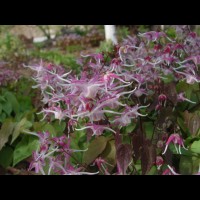 Epimedium grandiflorum 'Tama No Genpei'
Epimedium grandiflorum 'Tama No Genpei'
A floriferous, showy Japanese selection with masses of large, crisp, bi-colored lavender/pink and white flowers held above the foliage. The lovely flowers paired with attractive purple-flecked new spring foliage gives the plant a very soft look in bloom. First blooms are held on 8” stems, with stems elongating to 16”. Small leaflets.
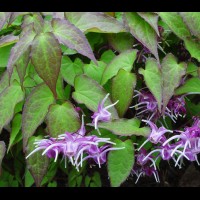 Epimedium grandiflorum 'Waterfall'
Epimedium grandiflorum 'Waterfall'
***2003 Cobblewood Introduction***
A large, lively, textural garden plant, full of movement. This appeared as a spontaneous seedling in the garden of Harold Epstein between E. grandiflorum f. flavescens ‘La Rocaille’ and E. grandiflorum ‘Yubae’. The medium-large, acutely tapered leaves stack in layers giving the appearance of flowing water. In spring, purple stippling is strongest at leaf edge, with an irregular mosaic of purple/red and green in the center, fading to green at the petiole. Large flowers gush forth on stems angled upward along the fringes of the foliage. Deep rose-purple sepals angle back from white spurs that flush amethyst as they near the narrow cup. 16” in bloom with colorful second growth to 20".
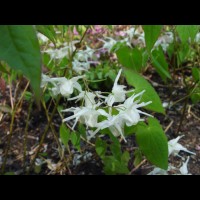 Epimedium grandiflorum 'White Queen'
Epimedium grandiflorum 'White Queen'
Common in the U.K., but quite rare in the U.S., Darrell received his origi
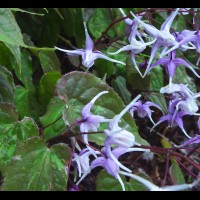 Epimedium grandiflorum 'White Splash'
Epimedium grandiflorum 'White Splash'
Early spring leaflets are marked in a bright batik of olive, apple green, soft salmon-pink and white. As the foliage matures, the pink fades, leaving white irregular patches against a patchwork of many shades of green, lasting well into the season.
This plant came from Japan as “E. grandiflorum – Variegated”. We gave it a cultivar name to distinguish it from the others sold as such in Japan. Flowers are similar to those of the species, with medium-lavender inner sepals and white spurs. A smudge of lavender decorates the white cup. To 12” high.
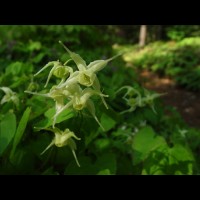 Epimedium grandiflorum 'Yellow Princess'
Epimedium grandiflorum 'Yellow Princess'
***2000 Cobblewood Introduction***
Simply beautiful, the small leaflets of this form a low 5-1/2” mass with large, clean, light yellow flowers held aloft on stems to 10”. The spent flower stems are eventually engulfed by a second growth flush. From high elevations in Japan, it emerges late and is one of the last of E. grandi
(Synonyms: ‘Crimson’, 'Crimson Beauty’, 'Rose Queen’)
One of my favorites, this plant is often mislabeled as ‘Rose Queen’. It arrived in the west many dec
Yubae’s beautiful large rosy-red flowers have white spur tips. This bright flower color can read from a long distance in the garden. The young foliage, purple-bronze in spring, is only 8” tall at first bloom. A second flush of flowers and foliage reaches 18”. Early bloomer.
 Epimedium grandiflorum f. flavescens #2
Epimedium grandiflorum f. flavescens #2
Of the over 50 distinct clones of E. grandiflorum f. flavescens that Darrell brought back from Japan, this is by far the earliest to bloom with large, pale greenish-yellow flowers held below large, elliptical, bright apple green leaflets. Large, mature leaflets etched by the nearly parallel main veins make a bold, elegant garden statement. From the Kyoto Botanic Garden in Japan, it is very different from other clones circulating in the U.S. 20" tall. Clear yellow fall foliage. Spreads by 2-4" rhizomes.
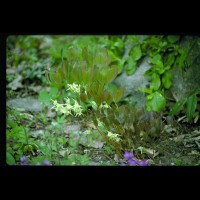 Epimedium grandiflorum f. flavescens #3
Epimedium grandiflorum f. flavescens #3
Originally sold by Siskiyou Rare Plant Nursery under the invalid name E. macranthum ‘Aureum’. At 14”, it is shorter than most other E. grandiflorum f. flavescens clones offered here. Beautiful red-copper young leaflets unfurl over large, pale yellow flowers. After bloom, large, bold, oval-shaped leaflets expand to form an impressive mound. Clear yellow fall foliage color. Spreads by 2-4" rhizomes.
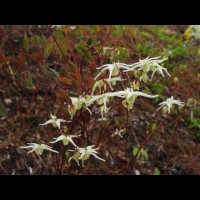 Epimedium grandiflorum f. flavescens #4
Epimedium grandiflorum f. flavescens #4
Very different from other forms in commerce—almost like a straight E. grandiflorum. 20” tall, with 27 small leaflets per leaf, lightly bronze-tinted in spring. Large soft yellow flowers are held out from beneath the many small leaflets on long peduncles. Thin, wiry red stems arch out over the flowers, enhance the overall graceful textural nature of this clone.
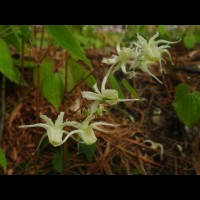 Epimedium grandiflorum f. flavescens #5
Epimedium grandiflorum f. flavescens #5
Reminiscent of E. koreanum ‘Harold Epstein’, with large soft yellow flowers and huge rounded leaflets, nearly as broad as long. However, its spreading rhizomes only grow 2-6” per year, forming a much thicker mass in the gar
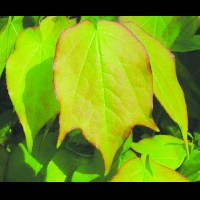 Epimedium grandiflorum f . flavescens #6
Epimedium grandiflorum f . flavescens #6
Cc. 950188
Distinctive for the exaggerated extra points on each terminal leaflet. In spring, the large leaflets have a thin dark bronze edging with an overall light bronze blush. The smooth leaf surface and very delicate spring coloration creates a soft effect. Sizeable clusters of large, showy, pale yellow flowers are borne on long sprays beneath the leaves as they unfurl. 16” in bloom, to 20” tall. Spreads 2-4" per year.
Prof. Stearn’s 1938 Epimedium monograph mentions “Faurie’s robust specimens from Aomori in Honshu, Japan”. Darrell explored the region in 1997. After several inquiries, their host led them to a steep hillside of densely planted Cryptomeria japonica, beneath which grew knee-high Epimediums with leaflets the size of your hand! Spring leaflets often flushed bronze-purple on 15-24” stems. Large, light yel
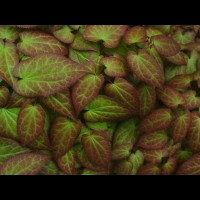 Epimedium grandiflorum f. flavescens 'Chocolate Lace'
Epimedium grandiflorum f. flavescens 'Chocolate Lace'
***2003 Cobblewood Introduction***
Yummy, milk-chocolate tones on the emerging spring leaflets later melt into a rich burgundy tracing over a green backdrop with deep purple edges, before they mature to green. Large creamy, yellow-green flowers are held below the foli
 Epimedium grandiflorum f. flavescens 'LaRocaille'
Epimedium grandiflorum f. flavescens 'LaRocaille'
Originally offered in the 1970’s as E. grandiflorum f. flavescens by George Schenk of The Wild Garden, Bothel, WA. Plants established in Harold’s garden 25 years before grew into a large mass 6’ across. Its vigorous habit, long arrow-shaped leaflets and large, pale yellow flowers moved Harold to name it after his garden. Foliage is flushed a beautiful red in spring. 14” tall.
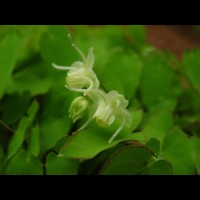 Epimedium grandiflorum var. coelestre 'Alpine Beauty'
Epimedium grandiflorum var. coelestre 'Alpine Beauty'
***2000 Cobblewood Introduction***
Extremely rare in the wild and in cultivation, this is the only Epimedium that grows at montaine heights. Beauti
 Epimedium grandiflorum var. higoense 'Bandit'
Epimedium grandiflorum var. higoense 'Bandit'
Although Darrell has obtained this clone from several sources, he has traced it back to a 1981 We Du Nursery purchase from Japan. It is very different from the clone he got from them eleven years later. After many years of trialing, he named it in 2000 as it is very distinct and has the most striking, dark purple band around the edge of each small leaflet as it emerges in spring. Medium-sized, creamy-white flowers cover the plant at 6” tall, with a second flush of banded leaves to 10” as the older leaves green up. A customer favorite.
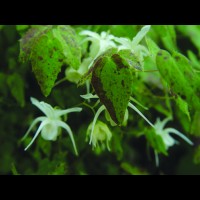 Epimedium grandiflorum var. higoense 'Confetti'
Epimedium grandiflorum var. higoense 'Confetti'
***2007 Cobblewood™ Introduction***
A marvel of texture. Each leaf is composed of up to 50 small leaflets, and most are uniquely speckled, flecked and splotched with dark purple in spring. Our leafiest clone of Epimedium by far. 7” high in bloom, bearing hordes of elegantly crafted, medium-sized white flowers. All flower parts are thin and tapered, the whole giving the effect of delicate spiders floating over the foliage.
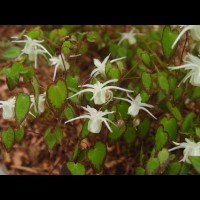 Epimedium grandiflorum var. higoense 'Saturn'
Epimedium grandiflorum var. higoense 'Saturn'
A 1991 We Du introduction named by Dick Weaver for the maroon band that circles each tiny spring leaflet. Only 4 to 5” tall in bloom, the second growth flush may reach 8”. Medium-sized, creamy-white flowers. Foliage provides a fine-textured effect in the garden. Later to bloom than most grandiflorums.
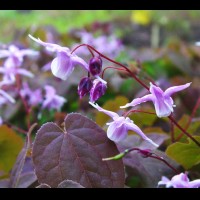 Epimedium grandiflorum var. violaceum
Epimedium grandiflorum var. violaceum
Exquisite deep chocolate, small, spring leaflets form a lovely background for the bright, medium- lavender flowers. One of the very earliest Epimediums to emerge and bloom in the nursery. Makes a clump 8-10” in bloom, with a second growth flush to 12”.
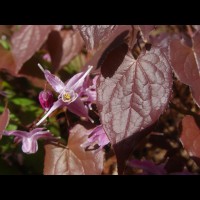 Epimedium grandiflorum var. violaceum 'Bronze Maiden'
Epimedium grandiflorum var. violaceum 'Bronze Maiden'
***1999 Cobblewood Introduction***
Spring leaflets emerge a glossy mahogany-red, resembling molten chocolate. This intense color complements the medium-sized lavender flowers. 8” in bloom, with a second growth flush to 12”. One of the earliest epimediums to bloom. Semi-evergreen.
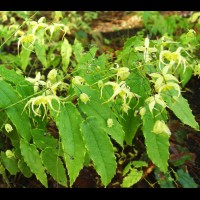 Epimedium ilicifolium
Epimedium ilicifolium
A particularly cold-hardy, Chinese evergreen species from Shaanxi Province. Darrell found it in three areas in Nov. 2000 at the highest elevation above snowline. He trudged up steep ravines through snow and freezing temps just to see it in the wild. The long, narrow, evergreen leaflets are especially spiny (ilici-=holly, folium=leaf), on stems to 10”. Large flowers with light green inner sepals and bright yellow spurs, on stems to 18”.
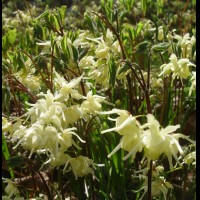 Epimedium koreanum 'Harold Epstein'
Epimedium koreanum 'Harold Epstein'
A very cold hardy clone with huge flowers for an Epimedium— gorgeous and butter yellow. Named in honor of Harold Epstein by plantsman Jerry Flintoff, its enormous leaflets can reach over 6” long and 4-1/2" wide. Spreads 6-12" a year. It usually takes 2-3 years to establish itself and be
From Guizhou Province in China, its large light lavender-pink flowers and medium-sized leaves are similar to those of E. brachyrrhizum-- elongated and arrow-shaped, with a corrugated texture. However, it spreads by thin rhizomes that grow 8”+ a year with foliage 6-8” tall. Forms a thick, low evergreen groundcover. Reddish fall color. Evergreen.
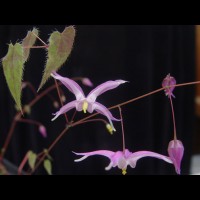 Epimedium leptorrhizum 'Hubei Treasure'
Epimedium leptorrhizum 'Hubei Treasure'
***2005 Cobblewood Introduction***
Traveling along the Sichuan/Hubei Province border in China on a transitional day between target locations in November of 2000, Darrell stopped to stretch his legs. There he found an Epimedium in the cracks of a short cliff along a farmer’s field. With long hairs on the leaves and long rhizomes, he identified it as E. leptorrhizum, and collected a few samples. Fortunately this clone has larger flowers with near-white spurs backed by rich pink inner sepals, a striking deviation from the typical pale lavender-pink blooms of this species. The evergreen leaves are larger than those of the species. Spreads by 2-4" rhizomes.
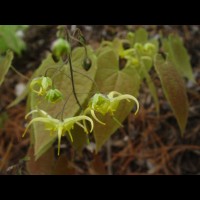 Epimedium lishihchenii
Epimedium lishihchenii
Collected by NACPEC in 1994 in Hubei Province, China, along with E. stellulatum. Produces large, bold evergreen leaflets that are heavy in substance. One of the few evergreen epimediums where the foliage makes it through many of our harsh winters. The large flowers have green inner-sepals and bright yellow spurs. Hardy to at least Zone 4. Grows to 12” tall. May exhibit various pastel shades in its spring foliage color. Fall color on some clones displays reddish markings on the leaves, as in accompanying photo.
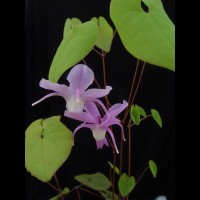 Epimedium macrosepalum
Epimedium macrosepalum
An evergreen and drought-tolerant species from the S.E. coastal region of Russia. The flower of this species makes up for its paucity of flowers with their size. The flowers have enormous (for an Epimedium) inner sepals that are a heavenly shade of lavender-pink. Unlike most inner sepals that follow the curve of the spurs, these petaloid structures reflex back like huge rounded wings, arching above the down curving spurs, like an insect taking flight. Both the cup and the tips of the spurs fade to white. Ground hugging foliage 4-8” high is composed of small to medium-sized rounded, heart-shaped leaflets that turn deep maroon over winter. Its low, running habit makes this species a good groundcover. Vigorously spreads by thin 4-12” rhizomes.
.jpg) Epimedium macrosepalum 'Sweet Rachel'
Epimedium macrosepalum 'Sweet Rachel'
***2010 Cobblewood Introduction***
This beautiful, smaller foliaged form has very shiny, bright burgundy leaves in winter if grown in some sun. The ground-hugging, heart-shaped leaves have the texture of the finest leather. Same beautiful, large rose pink flowers as the species and a reliable bloomer, but with very few flowers. Spreads by thin rhizomes which grow from 4-12”a year. From a plant collecting trip Darrell sponsored in cooperation with the U.S. National Arboretum. Drought-tolerant. Evergreen.
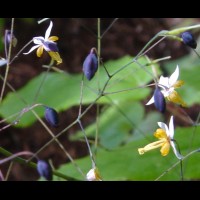 Epimedium myrianthum
Epimedium myrianthum
Although the flowers of E. myrianthum are tiny, with over 100 flowers per stem, they create a billowy mass. White inner-sepals with yellow petals, and iri
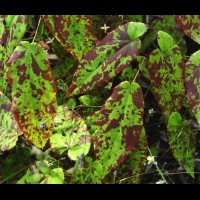 Epimedium myrianthum 'Mottled Madness'
Epimedium myrianthum 'Mottled Madness'
***2000 Cobblewood Introduction***
Of all of the plants and seedlings we have grown of this species, this clone stands out for its dark spring coloration. Large leaflets are heavily mottled for a month during spring, like a burgundy form of army camouflage. While the color eventually turns to green, it usually reappears once the temperatures dip in fall, and lasts through the winter in mild climates where the leaves remain evergreen. Bright airy panicles hold tiny white flowers that emerge from iridescently blue-black buds. 8-12”. Native to China.
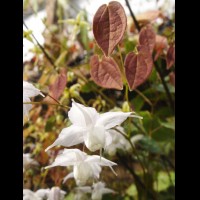 Epimedium ogisui
Epimedium ogisui
Named in 1993 by Professor Stearn after Mikinori Ogisu, who discovered it in China in 1992 growing beside a waterfall. Darrell collected a few divisions at that same waterfall in 1996. Although described as pure white, the inner-sepals are usually pale pink. A cliff dweller in its native habitat, the flower stems spread out nearly horizontally holding large flowers. Medium-sized evergreen leaflets are glaucous, uniquely oval-shaped often with red spring coloration. Spreads by 6-8” long, thin rhizomes. USDA zones 6-9.
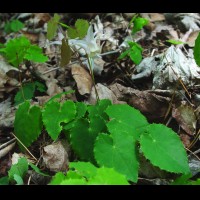 Epimedium pauciflorum
Epimedium pauciflorum
Native to the parched regions of western Sichuan Province in China, this species is drought-tolerant. The attractive, small, rounded, spiny-edged semi-evergreen leaflets sometimes exhibit splashes of reddish-brown in spring. Produces 2 to 4 medium-sized, flowers of the palest lavender-pink on sporadic flower stems, hence the species name pauci=few florum=flowers. Spreads by thin 8 to 12" rhizomes. Best used as a very low (4-6") groundcover.
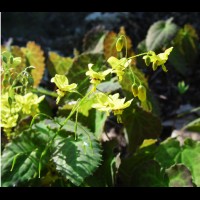 Epimedium perralderianum
Epimedium perralderianum
Native to the moist remnants of oak and cedar forest in northeast Algeria, this drought tolerant species forms a handsome evergreen ground cover. Smaller than E. pinnatum ssp. colchicum, it differs in that its heart-shaped, veined leaflets are in sets of three, with spiny edges that give textural interest. Flowers are much the same-- small, lemon-yellow, and rounded with diminutive mahogany spurs that bend upwards. Leaflets are patterned with red/bronze in spring and fall. Spreading rhizomes grow 2-4". First foliage flush to 4", second to 8" high. This clone is courtesy of the late David Barker, who held one of the national UK collections of Epimediums.
.jpg) Epimedium pinnatum ssp. colchicum
Epimedium pinnatum ssp. colchicum
Native to the mountainous areas of Georgia along the eastern coast of the Black Sea, this Epimedium is very drought tolerant. A workhorse groundcover for dry areas. Clusters of small, bright yellow flowers are produced on leafless stems above newly emerging leaves. Showy bright yellow inner-sepals back small petals that form a yellow cup. Short reddish spurs are held straight out against the inner-sepals. Spreads 6-8” a year creating a dense growth of large, rounded, shiny, deep evergreen leaflets on stems 8-10”.
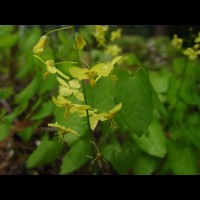 Epimedium pinnatum ssp colchicum L321
Epimedium pinnatum ssp colchicum L321
This Roy Lancaster collection was obtained from Robin White of Blackthorn Nursery. The dark evergreen leaflets are smaller and narrower than those of the other clones we grow, with a decorative wavy edge, making it a much more open plant, but one with a great deal of textural character. A favorite of mine. Otherwise, it is similar to the other clones. Spreads by 4-6" rhizomes. Drought tolerant.
.jpg) Epimedium pinnatum ssp. colchicum 'Thunderbolt'
Epimedium pinnatum ssp. colchicum 'Thunderbolt'
***2000 Cobblewood Introduction***
Collected in the former USSR Province of Georgia in 1973 by Skip March of the U.S. National Arboretum. We named this clone in cooperation with the Arboretum. Cool autumn temps turn the medium-sized, semi-glossy, evergreen leaflets either dark black/purple or a rich red mahogany, depending on the light exposure. An attractive “thunderbolt” pattern of green main veins overlays the fall color. Flowers have showy bright yellow inner-sepals. 10”. Spreads by rhizomes that grow 6-8” a year making this a great groundcover. Particularly drought tolerant.
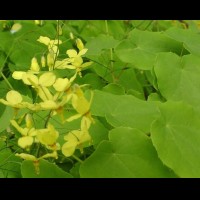 Epimedium pinnatum ssp. pinnatum
Epimedium pinnatum ssp. pinnatum
This eastern subspecies of E. pinnatum is uncommon in cultivation. Native to the Caspian forests of northern Iran, the late David Barker shared this with us when we visited his garden in Chelmsford, Essex, UK in 1998. Sprays of small, bright lemon-yellow flowers with tiny brown spurs erupt in early spring to 7” beyond the newly emerging foliage. While the flowers are different from ssp. colchicum in having spurs that are half the length, gardeners will notice the difference in plant habit. Generally taller with 9 medium-sized evergreen leaflets per leaf vs. 3-5. Flowers 3/4” in diameter. Leaflets are a clear spring green with a slight rose flush. Spreads by 8” rhizomes. Light red fall color. The earliest of the E. pinnatums to leaf out in spring.
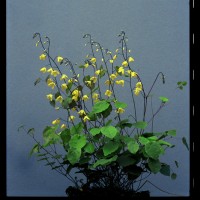 Epimedium platypetalum
Epimedium platypetalum
Native to China, 12 to 15” stems carry 10 to 20 dainty yellow bells suspended like tiny shuttlecocks, backed by tiny, white or reddish inner-sepals. The delicate blooms are held aloft on upright stems rising above small, rounded leaflets. Spreads by 8-12” long rhizomes, forming a low groundcover. Small, rounded, and slightly flecked new spring leaflets have few spines. While evergreen, the leaves flatten in the winter and are not very ornamental during that season. A particularly drought tolerant species.
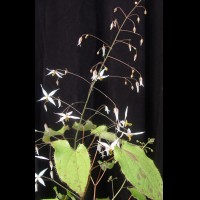 Epimedium pubescens "Shaanxi Forms"
Epimedium pubescens "Shaanxi Forms"
(Several clones/Cc. numbers)
Epimedium pubescens is generally hardy from Zone 6 south, but these clones from Shaanxi Province have proven hardier, growing well in Zone 5. Forms a leafy clump 12” tall/wide with the flower panicles reaching to 16”. Medium-sized, evergreen spring leaflets are flecked with crimson, and mature to a glossy dark green with spiny margins. Starry flowers are borne in large airy panicles with 1/2” long, narrow, white reflexed inner-sepals and tiny orange-yellow spurred petals. Slightly spreading by 1-2" rhizomes.
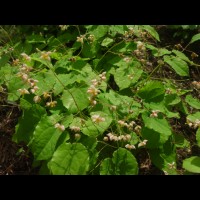 Epimedium pubigerum Cc. 920029
Epimedium pubigerum Cc. 920029
Attractive small, round, heart-shaped leaflets with a matte surface, a wavy edge and a bronze overlay in spring, form on stems 8 to 10" tall. Full sprays of very small, pink-flushed, creamy-white flowers hover well above the leaves at 16-20". Early bloomer that initially stays in a clump, but with age, throws short 1-3" rhizomes, with occasional longer ones. Semi-evergreen.
 Epimedium pubigerum Cc. 950215
Epimedium pubigerum Cc. 950215
This clone bears creamy-white flowers-- almost like tiny molars, creating a baby's breath effect-- held high above especially rounded, glossy dark green leaflets. Foliage 8-10" tall with flowers stems held at 16-20" tall. Drought tolerant. Semi-evergreen.
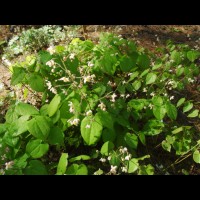 Epimedium pubigerum Cc. 000996
Epimedium pubigerum Cc. 000996
A unique running version of this normally clump-forming and especially drought tolerant species. Handsome corrugate bright green medium-sized leaflets form an attractive, open ground cover. Abundant flower sprays reminiscent of baby's breath cover the foliage extending to 16". Each small flower has cupped white sepals that sport a smear of rose color along their lengthwise edge. A slow spreader with 2-4" rhizomes. Foliage reaches 8". Semi-evergreen.
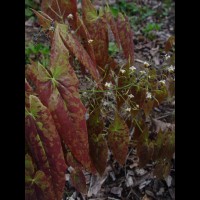 Epimedium sagittatum 'Warlord'
Epimedium sagittatum 'Warlord'
2007 Cobblewood Introduction
A very handsome species, long desired for its exceptionally large, arrow-shaped, evergreen leaflets up to 9” long (in fertile soil and full shade). The spring foliage color of this clone is a spectacular mosaic of various shades of maroon covering the entire leaflet. Side leaflets have exaggerated outer lobes. Tiny flowers with white inner-sepals and golden spurs, are produced in congested panicles of 50 or more against the dark, glossy foliage. Grows to 18” tall here with much more narrow leaflets than the typical species. A slow grower, it forms an impressive clump over time.
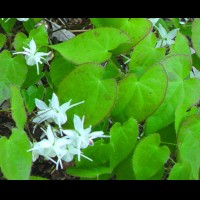 Epimedium sempervirens
Epimedium sempervirens
Medium-sized, crisp, white flowers bloom above long tapered leaflets. One of the earliest epimediums to bloom in spring. Foliage makes an 8” mound. Spring leaflets are touched with a band of red around their edge. A bright little harbinger of spring. Semi-evergreen.
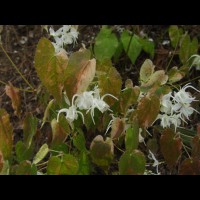 Epimedium sempervirens "Variegated #1"
Epimedium sempervirens "Variegated #1"
From Japan came rumors of a most spectacularly variegated Epimedium heavily dappled with white and pink and costing a small fortune. During Darrell's 1997 trip to Japan with Dan Hinkley he searched specifically for this fabled plant. Once he saw it he just had to have it—the most expensive Epimedium he's ever purchased! It was indeed the nicest variegated Epimedium he'd ever seen...and just as they said, the spring foliage is a swirling collage of creamy white, salmon-pink and apple green. What they didn’t mention was that the white portion of the variegation lasts well into the season.. into August here, before turning mostly green.
White flowers are produced above the semi-evergreen leaves. One of the shorter Epimediums at only 8” tall.
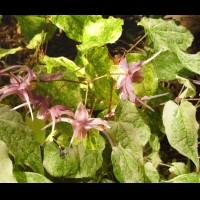 Epimedium sempervirens "Variegated #2"
Epimedium sempervirens "Variegated #2"
One of my absolute favorites. Grown for many years by Harold Epstein, Epimedium enthusiast, this may be a named Japanese cultivar. Medium-sized lavender flowers have spurs that curve inward back towards the cup. Flowers are held above medium-sized leaflets on stems to 9” high. Unusually long, narrow leaflets sport irregular dark flecking in the spring. Semi-evergreen.
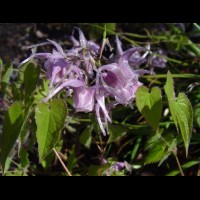 Epimedium sempervirens 'Aurora'
Epimedium sempervirens 'Aurora'
Dwarf form with large, dark silky, silvery lavender blooms with glossy, small/medium-sized leaflets. 6" tall in bloom with a second flush to 9". The new growth displays occasional dark flecking in spring. Second flush may have a pink blush as the photo shows. Often has good orange-red fall color when grown in bright shade or some sun. Named by Dick Weaver and sold by We Du as a cultivar of E. grandiflorum. Semi-evergreen.
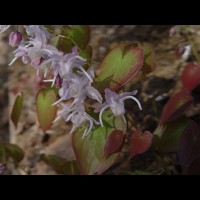 Epimedium sempervirens 'Candy Hearts'
Epimedium sempervirens 'Candy Hearts'
***2001 Cobblewood Introduction***
Exquisite spring foliage emerges an opalescent rosy-pink tone that slowly recedes over a month’s time to a rose border, before turning solid green. The showy large silvery lavender-pink flowers have wide inner-sepals and look like iridescent pearls against the colorful spring foliage. 9” tall. Semi-evergreen with medium-sized leaflets.
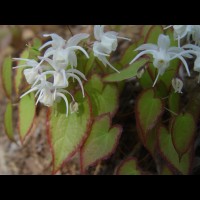 Epimedium sempervirens 'Cherry Hearts'
Epimedium sempervirens 'Cherry Hearts'
***2001 Cobblewood Introduction***
As Darrell began to sort out Epimediums in cultivation years ago, Don Elick kindly sent him this plant as “true” E. sempervirens. True it might be and while its large flowers are the usual white, with the typical evergreen leaves, the new spring foliage is anything but. Emerging a vibrant cherry red, it later turns green leaving a cherry edge before fading to summer green.
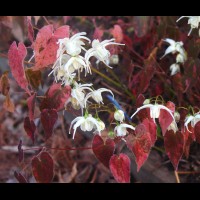 Epimedium sempervirens 'Creamsickle'
Epimedium sempervirens 'Creamsickle'
I have been growing several variegated forms of E. sempervirens, and have finally decided that this one is different enough to offer. The new spring growth surrounds its clean, white flowers a riot of deep pink and olive green swirls of color for several days during bloom. Later the leaves green up, holding onto traces of white variegation. Leaves are more limey-green in variegation than the other E. semp. 'Variegated #1' that Darrell bought in Japan, and have offered for years.
An attractive Japanese cultivar with sprays of large, medium laven
 Epimedium sempervirens 'Mars'
Epimedium sempervirens 'Mars'
A rare, rose-red form of this species, named by Dick Weaver from a plant he purchased from Japan. 6” tall in bloom with a second flush to 10” tall. Medium-sized leaflets. When grown well, ‘Mars’ produces up to 30 or more flowers per stem, forming a dense head. Very showy. Medium/large, dark rose-red flowers. Rusty red/salmon fall color.
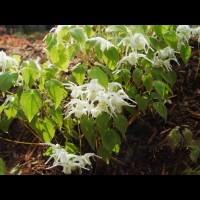 Epimedium sempervirens 'Okuda's White'
Epimedium sempervirens 'Okuda's White'
Introduced from Japan by George Schenk in the 1970’s. A rare and unusual spreading form of E. sempervirens, with 2-4” long rhizomes. The large, white flowers are typical of the species. Grows to 6-8” tall. Forms a nice, short, semi-evergreen groundcover over time. An early bloomer.
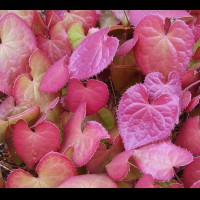 Epimedium sempervirens 'Passion Hearts'
Epimedium sempervirens 'Passion Hearts'
***2019 Cobblewood Introduction***
A great, new introduction from Massachusetts hybridizer Mark McDonough. Spring foliage emerges a deep chocolate brown and warms up as spring progresses, through a kaleidoscope of vibrant red tones. Eventually the color fades to the edges before greening up in a tidy mound of elongated, heart-shaped leaflets. Generous clusters of medium-sized flowers with light lavender sepals and a lighter cup dot the low mound of colorful spring foliage. Semi-evergreen.
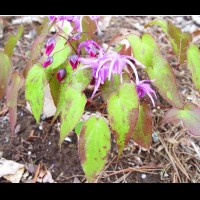 Epimedium sempervirens 'Rose Dwarf'
Epimedium sempervirens 'Rose Dwarf'
Originally offered by George Schenk in the 1970’s and still quite rare in the trade. We thank Jerry Flintoff for our original stock. Plants 5” tall in bloom with unusually long, narrow, medium-sized leaflets, gradually tapering to a thin point and flecked with bronze in the spring. Flowers similar to those of Violet Queen’, dark violet-lavender with long inner-sepals. An early bloomer. Semi-evergreen.
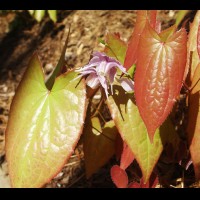 Epimedium sempervirens 'Secret Arrow'
Epimedium sempervirens 'Secret Arrow'
Epimedium sempervirens ‘Secret Arrow’ (Cc. 950140)
***2000 Cobblewood Introduction***
Unique, arrow-shaped leaflets distinguish this plant. Large lavender flowers face out¬ward with wide inner-sepals. Cool fall temperatures turn the leaves a beautiful salmon-egg red, with limey green streaks along the main veins
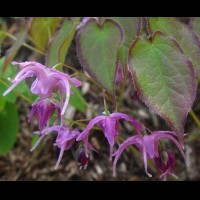 Epimedium sempervirens 'Shadow Dancer'
Epimedium sempervirens 'Shadow Dancer'
***2010 Cobblewood Introduction***
This Japanese sempervirens selection has strikingly beautiful banded foliage with a royal purple edge in spring, surrounding a interior flushed with purple. The large, violet-lavender blossoms have uniform coloring throughout. Grows to 12” in height. Semi-evergreen.
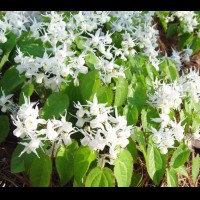 Epimedium sempervirens 'Snowshoe Lake'
Epimedium sempervirens 'Snowshoe Lake'
Epimedium sempervirens ‘Snowshoe Lake’ (Cc. 920033)
***2014 Cobblewood Introduction***
A white flowered very floriferous form of this extremely early bloomer. Sited in bright shade or a couple of hours of sun a day, it will produce clouds of clean white medium-sized flowers, 6” above the ground at the first thaw. Leaflets sport a delicate red line along their margins in early spring.
A cheerful and fitting tribute to my late brother George who lived on Snowshoe Lake in Alaska. 8-10” at maturity. An early bloomer.
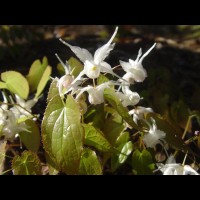 Epimedium sempervirens 'Vega'
Epimedium sempervirens 'Vega'
Named by Dick Weaver in 1995, but Darrell doesn’t think that he ever introduced it. He said, “the foliage seems almost varnished while young. It virtually glistens and it is still very glossy” (in mid-June). Dick’s original plant was from Leola Fraim of Waltham, MA in 1984. She received it from Florence Shaw in 1968. Leaflets remain glossy all season here, on stems to 6”. Pristine white flowers.
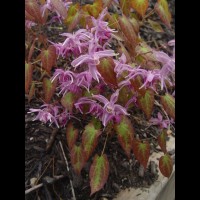 Epimedium sempervirens 'Violet Queen'
Epimedium sempervirens 'Violet Queen'
A spectacular Epimedium. This clone is an exact match for the plant originally named Epimedium violaceum in 1834 which was later changed to a variety of E. grandiflorum... all through the study of dried herbarium specimens. However, this plant is semi-evergreen and nearly identical to other clones Darrell received from west central Honshu including the plant depicted in Don Elick’s book, Japonica Magnifica. Perhaps it is a species of its own. This is the parent that gifted E. x rubrum, E. x versicolor ‘Versicolor’ and ‘Cupreum’ with colorful spring foliage.
Prized for its vibrant, cherry-red new growth and large, rich violet-lavender flowers with very long inner-sepals. Small/medium leaflets have a long, tapered point. Slow to propagate. 12”
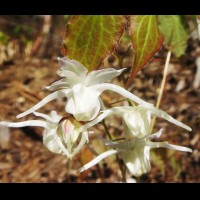 Epimedium sempervirens 'White Purity'
Epimedium sempervirens 'White Purity'
An especially vigorous, large-leafleted form of the species with the largest plant habit of the clones we grow. Harold nicknamed this plant “White Purity” for its large, pristine white flowers that are produced below the leaves. New spring leaves have a bronze cast. 10” tall.
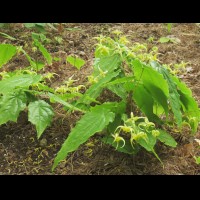 Epimedium sp. nov. 'Simple Beauty'
Epimedium sp. nov. 'Simple Beauty'
***2010 Cobblewood Introduction***
A new, as yet unnamed, species collected by Darrell in China that is one of his most favorite. It is a simple leaved seedling/clone of a species new to science that normally has 3 leaflets... and VERY rare as Darrell only found a few of them. The very large and simple corrugated evergreen leaves are just about the glossiest of all Epimediums and can reach over 6” long and 2.5” wide. The new spring growth has a slight flush of red with thin needle-like spines along the margins. Flower stems extend 4-5” above the foliage supporting large flowers with long, sulphur-yellow spurs and light green inner-sepals. Its thick, spreading rhizomes grow from 2- 8" a year. It has proven to be a great parent. Photos courtesy of Mark McDonough.
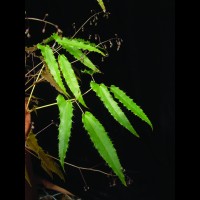 Epimedium sp. nov. 'Spine Tingler'
Epimedium sp. nov. 'Spine Tingler'
***2008 Cobblewood Introduction***
A form of an as yet, unnamed Chinese species collected by Darrell Probst in Sichuan Province. The long, narrow (1”) spiny leaflets emerge with a light chocolate wash in early spring. Later long, overarching stems of large lemon-yellow spidery flowers float over a mass of exceptional evergreen foliage. To 10".
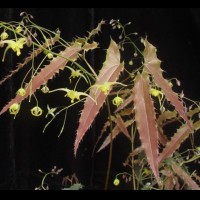 5Epimedium sp. nov. 'Tarantula'
5Epimedium sp. nov. 'Tarantula'
This clone has the narrowest leaves of any Epimedium in our entire collection. Delicate hair-like spines, run the edge of each leaf in a zig-zag pattern. Bears long, sprays of soft yellow flowers. Leaflets range in size from .25 to 5/8” across, and 3-4” in length, sporting an occasional simple leaf.
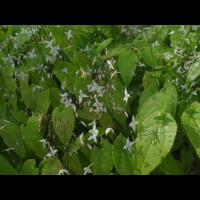 Epimedium stellulatum "Narrow Leaf Forms"
Epimedium stellulatum "Narrow Leaf Forms"
NACPEC (North American China Plant Exploration Consortium), is a group of ten botanic gardens and arboreta from across the U.S. and Canada, organized by the National Arboretum to explore areas of China on an annual or semi-annual basis. NACPEC has made several exciting discoveries, including this group of Epimedium stellulatum.
Discovered in several areas in the Qin Ling Shan of Shaanxi Province in 1996, the evergreen leaflets are medium in size, narrower than the original form and have especially spiny margins. 12-18”. The flowers are small white “stars” with tiny yellow petals on long, erect stems held well above the leaves. The floral display is like a miniature constellation suspended above spiny evergreen foliage. Early flowering and long-blooming, 12-18” tall. Hardy to Zone 4, possibly 3.
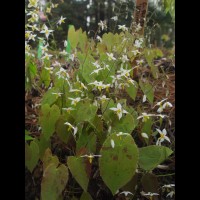 Epimedium stellulatum 'Wudang Star'
Epimedium stellulatum 'Wudang Star'
Collected in the Wudang-Shan by Roy Lancaster, this clone was the original collection used to describe the species. Plants produce numerous sprays of small, starry-white flowers with minute yellow spurs over spiny, evergreen foliage. The faded maroon-flecked spring leaflets of this clone are much wider and rounded than those of the straight species. 12-18”.
.jpg) Epimedium sutchuenense
Epimedium sutchuenense
This new Chinese species is from the mountains of southern Shaanxi and northwest Hubei Provinces where it blankets the slopes at approximately 6,000’ elevation. Superficially it resembles E. leptorrhizum, with large, lavender-mauve flowers. Spreads by long, thin 8-12" rhizomes. It produces two leaves on every flower stem, each with three medium-sized, smooth-faced leaflets. Uniformly short at less than 4” tall, it makes an excellent, low, evergreen ground cover.
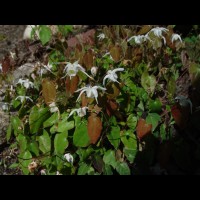 Epimedium trifoliatobinatum
Epimedium trifoliatobinatum
Found in only a few areas on Shikoku, Japan, it is treated as a valid species by Prof. W. T. Stearn. However, Darrell Probst thinks that it looks very much like a stabilized, true-breeding form of E. x youngianum, as the area to which it is endemic is within a region where E. grandiflorum and E. diphyllum naturally overlap. This clone is only 5” tall in bloom with a second growth flush to 9” tall. Medium-sized white flowers have spurs like E. grandiflorum but are smaller and in proportion to the overall diminutive habit of this clone. Small, rounded 1" wide, bronzed spring leaflets expand to green with maroon flecks.
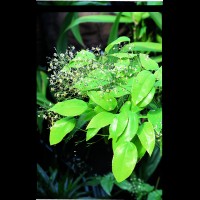 Epimedium truncatum
Epimedium truncatum
The large, evergreen leaflets of E. truncatum differ in that the usual two basal lobes are missing, as if snipped off by scissors! They have a smooth, semi-gloss finish and are held on 15" stems. Open panicles to 21” hold numerous tiny white-sepaled, yellow petaled flowers, covered with striking blue-black outer sepals in bud.
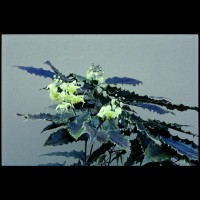 Epimedium wushanense "Spiny leaved forms"
Epimedium wushanense "Spiny leaved forms"
A beautiful Epimedium with very large, glossy, evergreen leaflets with large spines. Leaflets have good substance and are each up to 6" long, resembling a wildly serrated knife. This extreme spininess of the leaves reveals the relationship of Epimediums to the Barberry family.
Unlike most Epimediums where the individual flowers are spaced so that you can differentiate each bloom, these have abbreviated, congested heads of flowers, reminiscent of a lilac or hydrangea panicle. The large flowers have white sepals and butter-yellow cup and spurs. Unlike the typical E. wushanense, these variants are lower, leafier, with shorter bloom panicles and spread by 4" rhizomes. Many exhibit a black-purple-reddish tinge to the new spring foliage. Plants can reach a height of 12-15" . Spreads slowly.
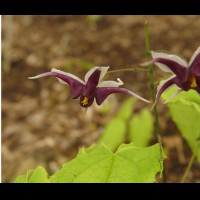 Epimedium zhushanense
Epimedium zhushanense
A new Chinese species, very rare in the trade, discovered near Zhushan and described in 1985. It is similar to E. acuminatum in leaf, flower and its clump-forming habit. The flowers have white or light lavender sepals and deep purple spurs and appear in spring on arching stems. A distinguishing characteristic of its large, evergreen, rough-surfaced spiny leaflets is their wooly undersurface. 8” high.
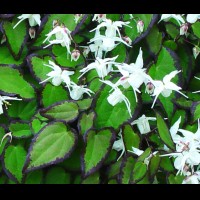 Epimedium 'After Midnight'
Epimedium 'After Midnight'
This cultivar was introduced by Diana Reeck of Collector’s Nursery. The spring leaflets initially open a gorgeous dark chocolate brown color which tranforms into a maroon band around the edge as the leaves expand. Multitudes of medium-sized white flowers shine bright, well above the first flush of small, elongated leaflets. 6” in bloom to 12”.
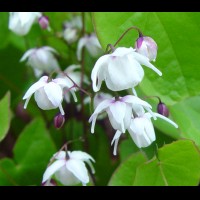 Epimedium 'Anju'
Epimedium 'Anju'
A very cute Japanese cultivar, with small, white flowers that have a tapered cup and short spurs. The medium-lavender outer sepals surround inner sepals with a kiss of lavender-pink at their base. Lime-green spring leaves have a thin, dark red margin at their edges.
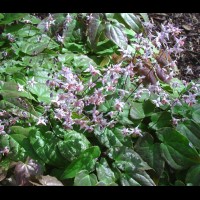 Epimedium "Asiatic Hybrid"
Epimedium "Asiatic Hybrid"
Washfield Nursery in England sold mixed seedlings of Asian parentage under the umbrella name “Asiatic Hybrid”, where Dan Hinkley originally purchased this clone. Tall sprays of delicate, small, pale pink flowers with deeper cups bloom above medium-sized, spring leaflets of a metallic pinkish-maroon hue. Blooms reach 12-15”. Semi-evergreen, arrow-shaped leaflets to 10".
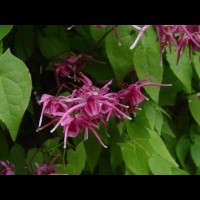 Epimedium 'Beni Chidori'
Epimedium 'Beni Chidori'
An attractive Japanese variety, given the name "a thousand red-birds chirping' and that is what it truly looks like in bloom- clusters of showy reddish-purple flowers with sepals a lighter shade of the same color. The medium-sized leaflets form a mound of bright green foliage to 10 in bloom, 18-20" high in second growth. Spurs are tipped in white. A very floriferous clone.
 Epimedium 'Beni Goromo'
Epimedium 'Beni Goromo'
A colorful, attractive Japanese cultivar with small, medium-lavender flowers held out in clusters against bronze-maroon spring foliage. The rich flower color lightens toward the tips of the curved spurs. Antique red fall foliage color. Reaches 12”-14”.
.jpg) Epimedium 'Black Sea'
Epimedium 'Black Sea'
Prized for its dark, glossy, near-black evergreen winter foliage whose color change is triggered by cool seasonal temperatures. Medium-sized leaflets on 8” stems form a thick groundcover. In spring 14” flower stems rise above the foliage carrying a myriad of small, diaphanous yellow flowers with pale orange veins. Semi-spreading, by 3-5” long rhizomes. An early bloomer, with foliage 12-14" high.
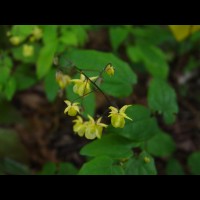 Epimedium 'Buttered Popcorn'
Epimedium 'Buttered Popcorn'
***2001 Cobblewood Introduction***
This spontaneous hybrid between E. x setosum and E. davidi appeared in Harold Epstein’s garden in 1996. The plentiful, sunshine-yellow flowers bloom in long, thin sprays, just above the foliage to 15”. The charming small, yellow "box-shaped" flowers have a flared cup with short, sassy spurs and a red rim around the inner-sepals.
Small to medium-sized evergreen leaflets form a mass 10” tall. The leaflets are similar to those of E. davidii, but are longer and narrower, becoming dark green or even black-purple in winter. Grows more vigorously in northern gardens than E. davidii, producing a larger clump in less time.
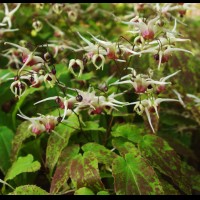 Epimedium 'Domino'
Epimedium 'Domino'
***2004 Cobblewood Introduction***
Absolutely stunning in the garden-- a true specimen epimedium. Long, showy panicles of creamy white flowers with an abbreviated maroon cup are highlighted against handsome mottled foliage in spring. Elegant elongated spring leaflets are sponge-painted in various shades of maroon. Deep reddish-purple outer sepals and dark purple pedicels. Forms a 12-14" mound of spiky evergreen foliage with soft spines, covered in a halo of long flower stems to 16”. May re-bloom and produce a second flush of mottled new growth to 18" under favorable conditions of humus-rich soil and adequate moisture.
.jpg) Epimedium 'Enchantress'
Epimedium 'Enchantress'
A stunning cultivar from Washfield Nursery in England, a result of Elizabeth Strangman’s cross of E. dolichostemon by E. leptorrhizum. Beautiful silvery-pink, medium-sized flowers bloom well above long, narrow, evergreen leaflets (up to 10" in height) with undulating margins. Rhizomes grow 2-4” a year. Reliable deep red fall/winter color.
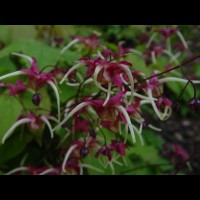 Epimedium 'Flame Thrower'
Epimedium 'Flame Thrower'
***2009 Cobblewood Introduction***
Cheerful cherry red and creamy yellow flowers dance above the foliage of this hybrid from Darrell Probst. The inner sepals have decorative undulations to their shape, resembling flames licking upwards from the top of the flower. This cross between deciduous and evergreen parent plants gives this hybrid both vigorous growth and deep green, spiny leaflets of good substance. Drought-tolerant.
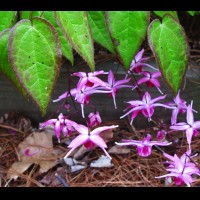 Epimedium 'Flamingo Dancer'
Epimedium 'Flamingo Dancer'
A Japanese selection named by Diana Reeck of Collector’s Nursery. Produces clusters of two-toned bright pink flowers. A narrow, deep cherry pink cup moves into lighter pink spurs subtended by darker sepals. Bright white spur tips make for a lively color combination. Each full panicle of bright flowers arches gracefully out over the beautifully speckled spring foliage. 10” high.
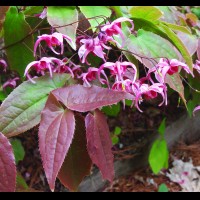 Epimedium 'Hot Lips'
Epimedium 'Hot Lips'
An E. acuminatum hybrid from Diana Reeck of the former Collector's Nursery, with multi-toned flowers of hot pink with the long spurred petals that are decidedly hotter than the broad sepals. Flower stems are tinged burgundy red. Long narrow foliage emerges a reddish pink. Given a bit of bright shade or moderate sun in the north, the plant can reach 20” high. Its bright blooms and bold semi-evergreen foliage draws your eye from quite a distance.
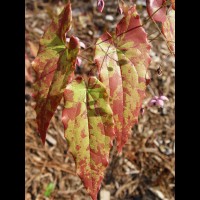 Epimedium 'Kaguyahime'
Epimedium 'Kaguyahime'
From Japan (via Mikinori Ogisu & Robin White) comes this delicately beautiful hybrid of E. acuminatum and E. dolichostemon. 15-18” stems carry sprays of small flowers with dark reddish-purple spurs and light rose-pink inner sepals. Long, slender arrow-shaped, medium-sized leaflets are jagged edged and beautifully mottled with various shades of red in spring. Vigorous for an semi-evergreen Epimedium, it is one of my favorites, and is named after a popular Japanese folk princess.
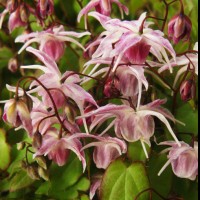 Epimedium 'Koharu'
Epimedium 'Koharu'
Another floriferous Japanese selection. Medium sized flowers cover this plant. Flowers have a lavender pink cup backed by a lighter pink and white sepals with pink edges and spurs that lighten toward the tips. Flowers are held on dark red pedicels. The small spring leaflets edged in a thin red line.
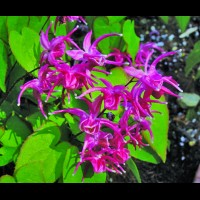 Epimedium 'Kuki'
Epimedium 'Kuki'
Heavy clusters of flowers dripping with deeply saturated color distinguish this beautiful Japanese selection. Numerous full clusters of reddish-purple flowers bloom against a background of fresh spring-green foliage. Each curved spur is tipped in white. A thin red line scribes the edge of each medium-sized new spring leaflet.
 Epimedium 'Lemon Zest'
Epimedium 'Lemon Zest'
***2005 Cobblewood Introduction***
From low, dense rosettes of small, shiny, rounded semi-evergreen leaflets flushed bronze in spring, emerge many erect racemes up to 12-15” high of cheerful, bright lemon-yellow bells. A slowly spreading hybrid which throws occasional rhizomes. A hybrid created by Darrell Probst. Foliage to 6". Flowers to 12".
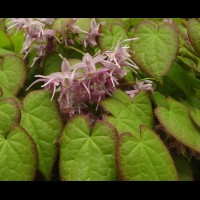 Epimedium 'Lilac Cascade'
Epimedium 'Lilac Cascade'
***2001 Cobblewood Introduction***
In spring the new foliage emerges in beautiful shades of rose and pink. By bloom time, the leaflets turn almost solid green with a purplish-red border, forming a perfect mound of cascading foliage. Just above the leaves are clusters of rich violet-lavender flowers. Later, a second flush of vibrant hot raspberry-pink foliage emerges and remains colorful for several weeks. 6 to 8” tall in bloom with the second flush to 12-14”. From Darrell Probst's cross between E. sempervirens ‘Candy Hearts’ and E. grandiflorum ‘Yubae’. The foliage is like the former— semi-evergreen, medium-sized round hearts. Drought-tolerant.
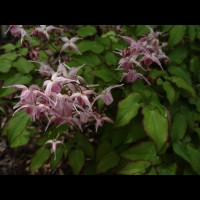 Epimedium 'Making Waves'
Epimedium 'Making Waves'
A 2003 Collector’s Nursery introduction, named for its exceptional wavy-edged leaflets with a soft, irregular maroon band in spring. Out-facing, long spurred mauve-pink flowers are accented with soft pink and held well above the foliage, on dark, nodding stems. Late blooming.
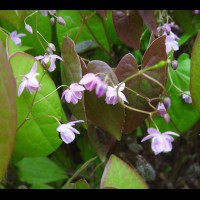 E. 'Mine No Fubuki'
E. 'Mine No Fubuki'
A delicate Japanese cultivar with chocolate-tinted new foliage, which balloons up to convex, light-green leaflets edged in bronze. Dainty, bell-shaped, spur-less flowers hang from drooping pedicels. They emerge a deep mauve and fade to a light lavender-pink. Delicate in flower with handsome, bold, semi-evergreen foliage to 14”.
 Epimedium 'Ninja Stars'
Epimedium 'Ninja Stars'
***2016 Cobblewood Introduction***
A vigorous hybrid of two as yet unnamed, handsome species with particularly nice foliage collected in Sichuan Province, China by Darrell Probst. Long, narrow, very evergreen spiny leaflets form a crown of foliage 10-12” tall. Long sprays of spidery sulphur-yellow flowers scatter above the foliage. The multi-branched, spreading rhizomes grow 4-6” per year. New leaflets display a light bronzy-pink on first and second growth flushes in spring.
 Epimedium 'Pink Champagne'
Epimedium 'Pink Champagne'
***2007 Cobblewood Introduction***
Perhaps the most all around beautiful Epimedium of those that Darrell has developed so far! Upright, heavy flowered panicles of pink and raspberry flowers float well above handsome, mottled foliage in spring. Medium pink sepals cap the top of each widely-arched spur. From the yellow spur tips that reveal their treasure of nectar, the color changes from white to a rich, berry pink, as if the cup was dipped in raspberry sorbet. Elongated, evergreen medium-sized arrow-shaped leaflets contrast purple mottling against a green background. A vigorous grower, it puts on an incredible show with occasional re-bloom if it is happy in its environment. 12" tall with flower stems reaching 16".
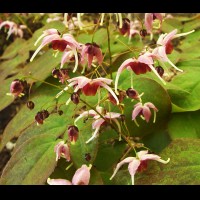 Epimedium 'Pretty In Pink'
Epimedium 'Pretty In Pink'
This 2012 Plant Delights Nursery introduction by Tony Avent is a vigorous E. grandiflorum hybrid with exceptional foliage. Small clusters of large, showy flowers with pink spurs and a raspberry cup are held just above the leaves during the mid-late Epimedium bloom season.
The new spring growth is patterned with subdued maroon flecks, eventually hardening off as handsome, glossy, medium-sized green leaflets, followed by a flush of blush pink second growth foliage. Tony describes the leaflets as "tardily deciduous"-- what I call "semi-evergreen". One of the best for thick, lustrous summer foliage. To 12".
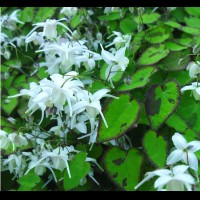 Epimedium 'Serendipity'
Epimedium 'Serendipity'
Epimedium 'Serendipity' (Cc. 060300)
***2017 Cobblewood Introduction***
A chance open-pollinated seedling of E. pauciflorum brought to my attention by to Elaine Chittenden of Smith College Botanic Garden, this selection is an excellent white-flowered, spreading Epimedium-- a rare find. Low and vigorous with loads of cheerful, white flowers (touched with light lavender, but they “read” as white) are scattered 8 to 10” above small, chocolate-edged and irregularly speckled leaflets-- quite unlike any E. pauciflorum I know. Similar to E. grandiflorum var. higoense in size and shape, but it spreads with 1-4” long rhizomes. Initially forms a 4-6” high, dense groundcover, perfect for small gardens or small spaces. Sparse second growth flush to 12". Semi-evergreen. Now how is that for a happy chance!
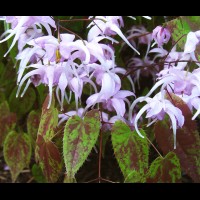 Epimedium 'Short Story'
Epimedium 'Short Story'
***2019 Cobblewood Introduction***
A showy, robust, new hybrid from Massachusetts breeder Mark McDonough. This unique selection combines the best of evergreen E. brachyrrhizum and deciduous E. grandiflorum. Spring emergence starts with an upright filigree of bronze stems and small leaflets, giving high visibility to luscious clusters of large silvery pink flowers with conspicuously down-turned spurs. As the leaves expand they are mottled in soft red. The flowers are held high and more prominently than in brachyrrhizum, for a fine display. The second flush of semi-evergreen foliage is just as dramatic as the plant is in bloom, boldly marked with bright red over chartreuse green.
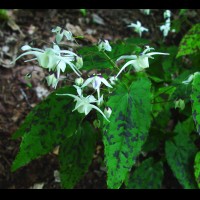 Epimedium 'Splish Splash'
Epimedium 'Splish Splash'
This beauty is a 2013 Plant Delights Nursery introduction that is certainly worth of a place in the garden. The arrow-shaped spring leaflets are heavily mottled in rich mahogany during the cool spring weather. The dark green mottled foliage serves as a great background to show off the multitudes of clean white flowers. Up to 12" in bloom. Semi-evergreen.
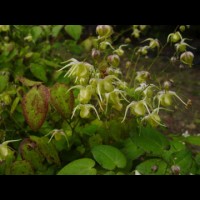 Epimedium 'Sunshowers'
Epimedium 'Sunshowers'
***2008 Cobblewood Introduction***
This diminutive in bloom, but fast growing cultivar was created by friend Kelly Dodson of Far Reaches Farm. Cheerful, medium-sized light yellow flowers with straight, outfacing spurs are backed by short pink sepals. Numerous, erect flower panicles are held high above the foliage to 8”. Small spring leaflets are showered with red speckles. Re-blooms with secondary flushes of flecked growth to 12-14" for added appeal. This long blooming clone literally “rains” flowers. Semi-evergreen.
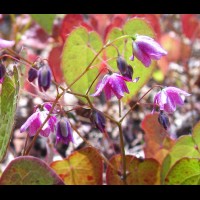 Epimedium 'Tanima No Yuki'
Epimedium 'Tanima No Yuki'
A charming Japanese cultivar with deep rosy-mauve, bell-shaped hanging flowers held above red stained and speckled medium-sized green leaves to 10”. Provides a riot of color in spring.
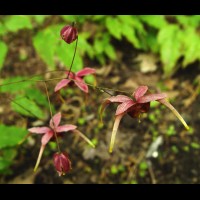 Epimedium 'William Stearn'
Epimedium 'William Stearn'
A hybrid from Robin White of the former Blackthorn Nursery in Hampshire, England. As one of the earliest "red" flowering epimediums, it was named for the late William Stearn who wrote the monograph on Epimediums in 1938 (revised in 2002 by Timber Press).
The arrow-shaped, semi-evergreen leaflets form a handsome clump, exhibiting reddish-brown mottling in the spring. Produces short, few-flowered stems of muddy red and yellow flowers. I have found it to be slow to establish in the garden. The foliage is its greatest asset, in my opinion.
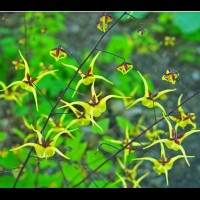 Epimedium 'Windfire'
Epimedium 'Windfire'
**2007 Cobblewood Introduction***
Wiry, black-red upright flower spikes rise above the foliage carrying large, canary yellow flowers with small, dark red sepals. The thin reflexed spurs give the flower a very elegant silhouette. Slightly spreading with an open habit, by rhizomes that grow 4” a year. Medium-sized semi-evergreen leaflets form a leafy, open base to 12”. Flower spikes to 20”.
 Epimedium 'Yokihi'
Epimedium 'Yokihi'
An outstanding late-blooming Japanese cross between E. davidii and E. grandiflorum ‘Yubae’, this clumping hybrid produces long arching 18” spikes of large spidery flowers. The dramatic flowers have a flared creamy yellow cup and long, slender spurs backed by short, bright reddish pink inner sepals. Medium green angular leaflets are flushed with bronzy red in spring. Semi-evergreen.
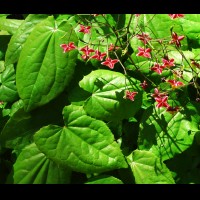 E x cantabrigiense "Red Form"
E x cantabrigiense "Red Form"
A tough, slightly-spreading natural hybrid of E. alpinum, which the deeply veined leaves most closely resemble, and E. pubigerum, which the floral sprays most resemble. One of many plants for which we are grateful to Jerry Flintoff, as Darrell has not found it elsewhere in the U.S. This clone was very common in many of the British gardens we visited in April 1998. The sepals are dark red rather than the pale salmon of the clone commonly cultivated in the U.S. Numeroua, small flowers bloom well above the leaves on loosely branched 18” stems. More vigorous than the U.S. form, with larger, medium-sized leaflets. Semi-evergreen.
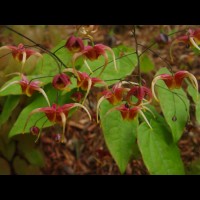 Epimedium x omeiense 'Akame'
Epimedium x omeiense 'Akame'
(Synonyms: ‘Emei Shan’, ‘Rigoletto’)
Mikinori Ogisu collected this clone on Mt. Emei in Sichuan, which Professor Stearn used as the type specimen for his description of E. x omeiense. The brilliant blooms have cherry-red inner-sepals and bright orange and yellow spurs. The cup is most intensely colored and edged in yellow. Open flower sprays are held above large, dark, handsome, glossy sagittate evergreen leaves that sometimes turn maroon in fall. 12-15” tall. A showy late bloomer.
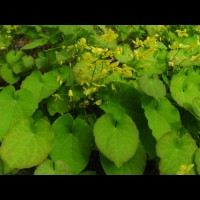 Epimedium x perralchicum
Epimedium x perralchicum
(Several clones/Cc. numbers)
Long confused in the U.S. as its parent, E. perralderianum, (the other being E. pinnatum ssp. colchicum). The floral differences are minor, but the hybrid is more vigorous and hardier, to USDA Zone 4. Large, evergreen leaflets have slightly wavy margins. Like its parents, the leafless stems have small rich yellow flowers reminiscent of Verbascum. Spreads by 4-6” long rhizomes. Leaves form a thick mass 8-10” high. An excellent drought-tolerant groundcover that remains exceptionally evergreen through our harsh New England winters.
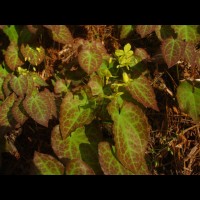 E. x perralchicum 'Frohnleiten'
E. x perralchicum 'Frohnleiten'
A drought-tolerant ground cover Epimedium prized for its colorful spring foliage, a gorgeous combination of reddish-bronze over the leaflet with an intricate pattern of green veins. Small, bright yellow flowers. Spreads 4-6” a year with medium/large evergreen leaflets that remain exceptionally evergreen through our harsh New England winters. 12” tall. Blends superbly with yellow-flowered late blooming Narcissus. One of the more common varieties available in the American market, and for good reason.
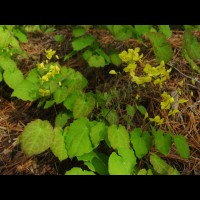 Epimedium x perralchicum 'Wisley'
Epimedium x perralchicum 'Wisley'
A spontaneous hybrid discovered at the Royal Horticultural Society Garden at Wisley, England. Small, bright canary-yellow flowers are produced just above the newly emerging spring foliage to 10”. Medium to large leaflets are dark green with lighter veins and a delicate ruffled edge. The surface of each leaflet is shiny and "puffed" up between the veins, giving it a lustrous, faceted appearance that catches the light. Spreads by 4-6" rhizomes. A great drought-tolerant ground cover with exceptional evergreen leaflets that hold up through most of our harsh New England winters.
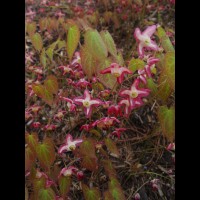 Epimedium x rubrum
Epimedium x rubrum
Often listed as variety or cultivar of E. alpinum, it is said to be a hybrid between E. alpinum and E. grandiflorum, however the colorful spring foliage could only have come from E. sempervirens ‘Violet Queen’. This slow-spreading hybrid (rhizomes 2-4”) is an excellent groundcover, forming a thick mass of medium-sized leaflets on 16” stems. Foliage flushes cherry-red in spring. The abundantly produced medium-sized flowers have red sepals, creamy-yellow spurs. Commonly referred to as drought-tolerant, but I haven't observed that to be true.
.jpg) Epimedium x rubrum 'Sweetheart'
Epimedium x rubrum 'Sweetheart'
***1997 Cobblewood Introduction***
This cultivar easily rivals Hosta as a bold textural garden accent. The first of Darrell Probst's Epimedium introductions, resulting from a 1991 cross he made between E. sempervirens ‘Candy Hearts’ and E. alpinum. Flowers with dark rose-red sepals bloom above and below the leaves. Leaflets are much larger, darker green and more rounded than is typical. Large, shiny new leaflets bear a thin red rim in spring. Semi-evergreen. 16" tall. Foliage is far superior to E. x rubrum, and the plant is much more drought-tolerant. Spreads by 2-4" rhizomes.
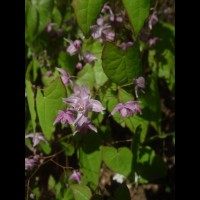 Epimedium x sasakii Cc 950137
Epimedium x sasakii Cc 950137
In Japan, wherever the habitats of E. sempervirens and E. x setosum overlap, hybrids occur. These highly variable hybrids were given the name E. x sasakii by Japanese botanists. However, the name is still little recognized by western botanists. All of the clones we've grown so far are semi-evergreen. 6” tall in bloom, second flush to 16”. Small, charming dark grayish-lavender flowers. In spring the leaflets are defined by a dark, thin, mascara-like maroon line at the edge of the leaf. Fall color changes to a taupe or sometimes scarlet with green veining.
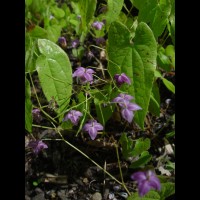 Epimedium x sasakii 'Melody'
Epimedium x sasakii 'Melody'
***2001 Cobblewood Introduction***
A hybrid between E. x setosum and E. sempervirens—violet, from Harold Epstein’s garden. Medium-sized, spiny, semi-evergreen leaves form a dense clump 7” tall. Lime-green new leaflets are attractively flecked with dark purple in spring. Numerous sprays of small light lavender flowers with tiny, sharply down-curving spurs appear above the foliage to 12”. The foliage often turns red with green veins in autumn. Offers a beautiful flower/foliage combination and is a distinctive addition to the garden.
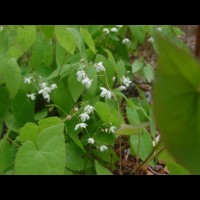 Epimedium x setosum Cc. 950163
Epimedium x setosum Cc. 950163
This is the typical form of this naturally occurring fertile hybrid collected in northern Kyushu, Japan. It is larger overall than others in commerce, growing up to 12” tall, with larger leaflets. Small white flowers are produced in sprays above the leaves that may appear bronzed in spring/fall. Semi-evergreen.
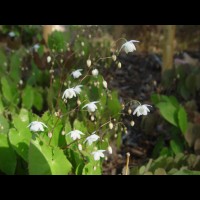 E x setosum Cc 960059
E x setosum Cc 960059
A very floriferous clone from the garden of Harold Epstein. Medium-sized leaflets with prominently spined margins on plants literally covered with numerous sprays of white flowers. 8-10” tall. Semi-evergreen foliage sports a reddish fall color. A favorite of the clones we grow, but each possesses individual charm.
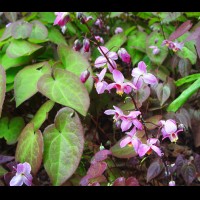 Epimedium x versicolor 'Cherry Tart'
Epimedium x versicolor 'Cherry Tart'
***1999 Cobblewood Introduction***
A spontaneous seedling originating in the garden of Judy Springer, formerly of Great Falls, VA. Erect stems sport numerous, outfacing flowers. Large, medium-pink inner sepals back flaming, cherry-red spurs with a bright, lemon-rimmed cup. Spreads slowly by 2-4” long rhizomes. Medium-sized leaflets are handsomely flushed with reddish-purple in spring with a mustard tone that changes to a dark burgundy blush in the fall. 12-15”. Blooms early and is drought-tolerant. Semi-evergreen.
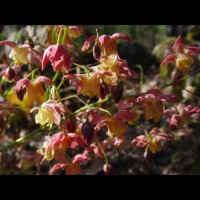 Epimedium x versicolor 'Cupreum'
Epimedium x versicolor 'Cupreum'
Thanks to Carla Lankow of Renton, WA for the original stock of this captivating plant. With the same parents as ‘Versicolor’, it is similar, but has a slightly deeper flower color and more intensely red spring foliage with green venation. Usually with more numerous, slightly smaller leaflets per leaf, each more angular and less rounded. Foliage to 9” and flowers to 12”. Rhizomes grow 4-5” inches/year. Semi-evergreen with deep orange to maroon fall color. An early bloomer, it is also very drought-tolerant.
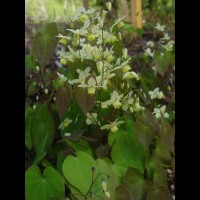 Epimedium x versicolor 'Neosulphureum'
Epimedium x versicolor 'Neosulphureum'
Undeservedly rare in cultivation, this counterpart to the more com
 Epimedium x versicolor 'Strawberry Blush'
Epimedium x versicolor 'Strawberry Blush'
***2004 Cobblewood Introduction***
Wide, antique pink sepals brushed with rose streaks back a cheerful lemon-yellow cup, which deepens to rose purple short, curved spurs. The soft pastel flowers blend beautifully with the pinkish maroon mottled new spring leaflets. Darkest at the edges, the color fades to green at the center of small/medium-sized leaflets, before turning entirely green. Handsome, medium green, glossy summer/fall foliage. Particularly drought tolerant. Semi-evergreen. Flowers/foliage to 10”. Spreading rhizomes grow 2-4" per year. Drought-tolerant.
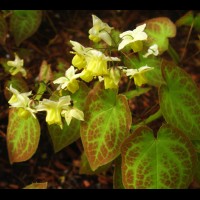 Epimedium xversicolor 'Sulphureum'
Epimedium xversicolor 'Sulphureum'
(Synonym: E. pallidum)
Superb in mass plantings, it spreads 4-5” a year, forming a thick groundcover of leaves that holds its own against weeds. Bears long sprays of pale yellow flowers with spurs nearly equal in length to the inner-sepals are produced above leaflets flushed red in spring. 10" tall in bloom. Semi-evergreen leaves. Drought-tolerant.
 Epimedium x versicolor 'Versicolor'
Epimedium x versicolor 'Versicolor'
(syn. E. x versicolor 'Discolor')
Quite rare in gardens, this has long been one of our favorite clones. Delicate flowers open a deep, rich pink-salmon, and fade over the course of several days. Large panicles of flowers hover above leaflets strongly flushed with red in spring. It spreads 4 to 5" a year forming a gorgeous mass of riotous color in spring. 14" tall. Early bloomer and drought-tolerant. Very similar to E. x versicolor 'Cupreum' in appearance and habit. Semi-evergreen.
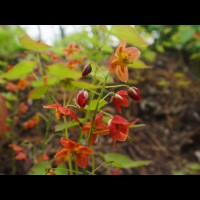 Epimedium x warleyense
Epimedium x warleyense
Bright orange flowers make this evergreen sterile hybrid between E. alpinum and E. pinnatum ssp. colchicum unusual. From Miss Willmott’s garden, Warley Place, England. Sprays of small flowers float above rounded, medium-sized, bright green, rounded leaflets. Spreads 5-6" a year with an open growth habit. Foliage to 8”, flowers to 12". Drought-tolerant.
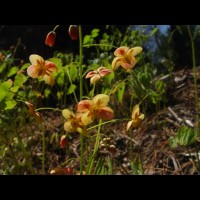 Epimedium x warleyense 'Orangekonigin'
Epimedium x warleyense 'Orangekonigin'
A shade or two paler orange than E. x warleyense in bloom, and a top-notch evergreen groundcover, this cultivar was introduced by Ernst Pagels of Germany. The inner-sepals are a soft shade of tangerine traversed by darker orange veins. Shorter rhizomes (2-4") spread to form denser clumps than the straight species, more effectively crowding out weeds. Early bloomer and drought-tolerant. 8-10" tall.
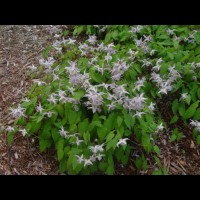 Epimedium x youngianum 'Akebono'
Epimedium x youngianum 'Akebono'
A charming small Japanese cultivar, with ¾” delicate, but full, light rose pink/lavender flowers. Small cup is backed by long, slender, pointed sepals with a white mid-rib. New growth has a reddish-cast at leaf edge. Foliage matures to small, milky-green leaves. 5” in bloom, second flush to 8”. Very floriferous.
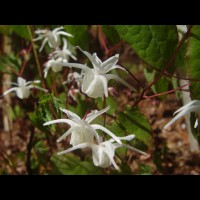 Epimedium x youngianum 'Azusa'
Epimedium x youngianum 'Azusa'
Large, clean, bright white flowers have long spurs and red outer-sepals and are held aloft the foliage on thin wiry red pedicels. Medium-sized, deep green leaflets of good substance have a striking silver overlay along the main veins, extending out over the leaf and lasting the entire season. 7” tall in bloom, second flush to 12”. Early bloomer with a very crisp, tidy appearance.
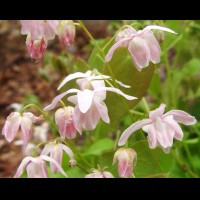 Epimedium x youngianum 'Baby Doll Pink'
Epimedium x youngianum 'Baby Doll Pink'
***1999 Cobblewood Introduction***
Either an unlabeled Japanese cultivar or a seedling from Harold’s garden. Small, spurless flowers are dark pink in bud, opening a pale pink edged in medium pink. A truly pink-flowered Epimedium. Extended bloom above small, light green leaflets with a pink tint in spring give this plant real garden merit. Only 3” tall in first flower, it continues to produce more flowers to 9” tall.
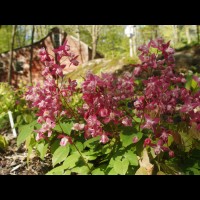 Epimedium x youngianum 'Be My Valentine'
Epimedium x youngianum 'Be My Valentine'
***1999 Cobblewood Introduction***
Named in honor of the late Betty Valentine of Berlin, CT, at the request of the CT chapter of NARGS, in celebration of her 90th birthday in1998. Betty loved Epimediums. She grew them most of her life. Covered in bright blooms at only 5-6”, the small-medium-sized flowers have deep rose-pink inner-sepals and white petals flushed rose, with very short, white spurs. Small leaflets. Second growth flush to 14” tall. Early bloomer.
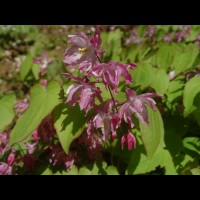 Epimedium x youngianum 'Beni Kujaku'
Epimedium x youngianum 'Beni Kujaku'
A fanciful Japanese "double-flowered hybrid whose name--literally translated-- means "Red Peacock". The cup is completely open, mimicking the inner-sepals in size and shape with short protruding spurs. Each flower part has a white or pale pink interior, the perimeter suffused with dark rose pink. Medium-sized “double” flowers bloom above small, medium green leaflets. 6” tall in bloom, second growth flush to 12”.
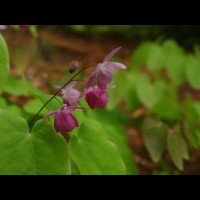 Epimedium x youngianum 'Capella'
Epimedium x youngianum 'Capella'
Introduced by Dick Weaver and one of Darrell's personal favorites. This clone has charming dark lavender-rose flowers that are small, simple and produced in profusion above small leaflets for a long period in spring. 8" in bloom with second flush to 10" with some re-bloom.
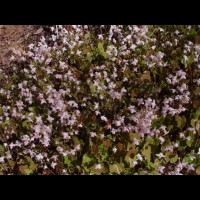 E x youngianum 'Fairy Dust'
E x youngianum 'Fairy Dust'
***2004 Cobblewood Introduction***
Small, simple, lavender-pink flowers with small white spurs lift their faces above the foliage in spring. The color deepens toward the edge of each flower part. Fresh spring leaves have the texture of silk and are tinted in a delicate shade of mocha. Compact growth at 7” in bloom, and flowers to 10”, creating a neat and tidy effect. Early bloomer. Semi-evergreen.
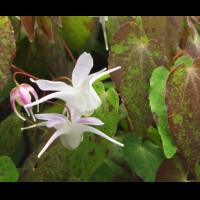 Epimedium x youngianum 'Freckles'
Epimedium x youngianum 'Freckles'
***2000 Cobblewood Introduction***
'Freckles' is a seedling that appeared in Harold Epstein’s garden among a mass of ‘Milky Way’, an obvious parent. Large grandiflorum –like flowers with white inner-sepals are flushed and veined lavender with white spurs. Introduced for its pure flower colors, but named for its lively, small spring leaflets, generously speckled in purple. 7” in bloom to 18”.
 Epimedium x youngianum 'Fukurasuzume'
Epimedium x youngianum 'Fukurasuzume'
A giant among the cultivars of E. x youngianum we've grown. The unique flowers are mostly made up of a “cup”. They have magenta-streaked, white inner-sepals horizontally perched above the nearly spur-less, pendent, white petals. Flowers hang in clusters below the small leaflets, slightly edged in red. 10” in bloom, reaching 15” at maturity.
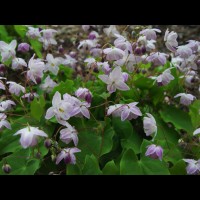 Epimedium x youngianum ‘Grape Fizz’
Epimedium x youngianum ‘Grape Fizz’
***2004 Cobblewood Introduction***
Small, rich, grape-purple buds open to release full, blue-lavender blossoms with irregular white highlights at the base of each part. Each flower has four vestigial white spurs. Flowers form a loose tumble above a low 5” mound of lime-green foliage. 7” in bloom. Long lasting bloom. New foliage has a brownish tint. The medium-sized leaves have acute basal lobes and deeply indented veins, producing a seer
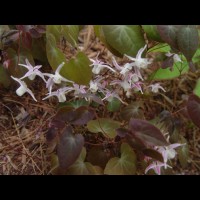 Epimedium x youngianum 'Hagoromo'
Epimedium x youngianum 'Hagoromo'
New growth is flushed purple, and matures to olive-green with a contrasting white star pattern at the veins near the leaf base. Medium-sized dainty white flowers appear among the foliage on deep-red petioles. The flowers are backed by narrow lavender/pink sepals, each edged in a crisp white line. 8” in bloom, growing to 12”.
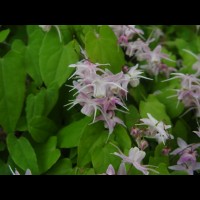 Epimedium x youngianum 'Hanagaruma'
Epimedium x youngianum 'Hanagaruma'
Ozzie Johnson of Marietta, GA bought this tiny floriferous selection for Darrell in a Japanese nursery. From a low mass of small leaflets only 6” tall, sprout 9” stems carrying many me
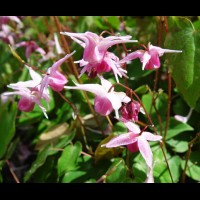 Epimedium x youngianum "Japanese Cultivar"
Epimedium x youngianum "Japanese Cultivar"
A charming Japanese cultivar that Epimedium connoisseur Harold Epstein purchased during his last trip to Japan, but lost the label. Sprightly, medium-sized, rose pink flowers appear above small leaflets flushed purple. White overlays the main veins of each small leaflet all season long. 6” tall in bloom, eventually growing to 9”.
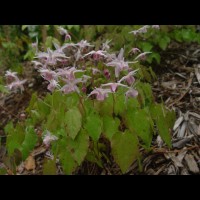 Epimedium x youngianum 'Jenny Wren'
Epimedium x youngianum 'Jenny Wren'
***2003 Cobblewood Introduction***
A dainty cultivar from the garden of John Marchacos, Berlin, CT. The small, dark green spring leaflets are speckled and splotched with burgundy against a softer purple wash like the markings of a tiny wren’s egg. Light, lavender-pink, medium-sized flowers stand perky and bright against the mottled foliage. 5” in bloom, to 12”. An early bloomer.
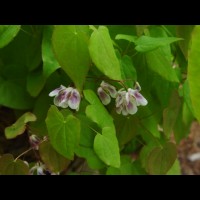 Epimedium x youngianum 'Kozakura'
Epimedium x youngianum 'Kozakura'
Siskiyou Rare Plant Nursery bought this unusual clone in Japan as E. x sasakii and offered it in 1995. Unusual in that the inner-sepals drop as the flowers open, leaving only pendulous white petals each with a deep lavender center spot. Small, bell-shaped flowers are borne above small leaflets. 9” tall in bloom. Second flush to 14-16"
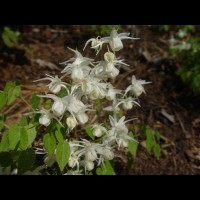 Epimedium x youngianum 'Lilliputian'
Epimedium x youngianum 'Lilliputian'
Friend Judy Springer shared this Don Jacobs (Eco Gardens) introduc
 Epimedium x youngianum 'Little Shield'
Epimedium x youngianum 'Little Shield'
***2004 Cobblewood Introduction***
Distinctive shield-shaped leaves are part of this plant’s allure. In spring a soft overlay of milky mocha covers the small to medium-sized leaves, heavily indented at the veins. 8” tall in bloom, with numerous, perky 3/4” white flowers held above the foliage. Spurs slightly longer than sepals. Semi-evergreen.
***2003 Cobblewood Introduction***
A spontaneous hybrid from the garden of John Marchacos of Berlin, CT, this lively offering sports a profusion of medium-sized, deli
 Epimedium x youngianum 'Milk Chocolate'
Epimedium x youngianum 'Milk Chocolate'
***2005 Cobblewood Introduction***
‘Milky Way’ sometimes produces sporadic new spring leaflets that are nearly solid purple. Darrell once found an entirely purple leaf, selected that division, and began propagating it to stabilize the characteristic. The resulting ‘Milk Chocolate’ produces small chocolate-purple leaves with tiny green flecks in spring. The color remains for weeks in contrast with the multitudes of white, medium-sized flowers. Semi-evergreen. 6” in bloom, to 12”.
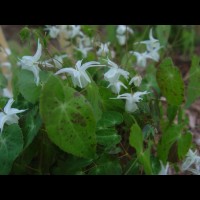 Epimedium x youngianum 'Milky Way'
Epimedium x youngianum 'Milky Way'
This Dick Weaver introduction
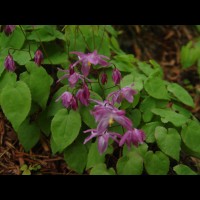 Epimedium x youngianum 'Murasaki Juji'
Epimedium x youngianum 'Murasaki Juji'
An unusual flower form giving it a "double-flowered" appearance. The petals mimic the inner-sepals in size and shape with short, white-tipped protruding spurs. Full, deep rose-lavender flowers lighten slightly at the center and edges. 7” in bloom. Forms a low, compact mound of dense me
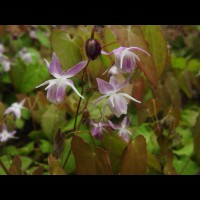 Epimedium x youngianum 'Murasaki Shikibu'
Epimedium x youngianum 'Murasaki Shikibu'
Purchased in Japan in 1997 at Gotemba Nursery, located in the shadow of Mt. Fuji. An adorable plant with a first flush of flowers on short 5” stems. The second flush of leaves/flowers to 9”. Very small new leaflets tinged with purple/brown. Medium-sized flowers have dark rose-purple inner-sepals, paler petals with nearly white, short spurs.
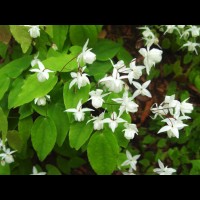 Epimedium x youngianum 'Niveum'
Epimedium x youngianum 'Niveum'
Talk about a low maintenance garden plant! The first time Darrell visited Harold Epstein, Harold pointed out several healthy clumps of ‘Niveum’ planted some 40 years previous and never, ever divided!
Crowds of small white flowers sit elbow-to-elbow above small, purple-tinted leaflets in spring. 10" in bloom eventually reaching 14". One of the more common varieties available in the American market.
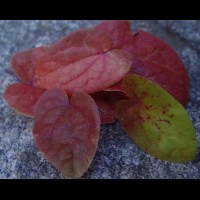 Epimedium x youngianum 'Otome'
Epimedium x youngianum 'Otome'
Another gem Ozzie Johnson purchased in Japan with small, spur-less white flowers flushed pink. The first flush of flowers starts at 5” with a second flush of medium-sized, rounded leaflets and some re-
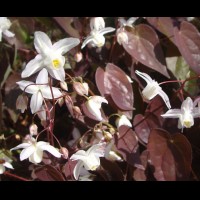 Epimedium x youngianum 'Purple Heart'
Epimedium x youngianum 'Purple Heart'
***2000 Cobblewood Introduction***
A Darrell Probst hybrid from a cross between E. grandiflorum var. violaceum and E. x youngianum ‘Pink Star’. Unlike other varieties where the purple spring foliage emerges at its darkest, and then fades, these small, semi-evergreen leaflets unfurl a greenish-purple and deepen to black-pur
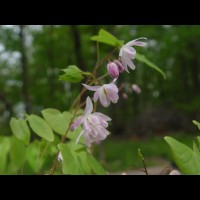 Epimedium x youngianum 'Roseum'
Epimedium x youngianum 'Roseum'
The very first Epimedium that Darrell grew as a teenager in Pennsylvania. Produces dainty pale lavender-pink bell-shaped flowers over a long period. 9" tall in bloom with a second flush of small leaflets to 12”. One of the more commonly found varieties in the American market.
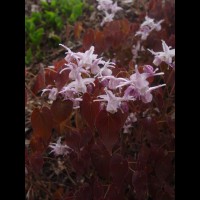 Epimedium x youngianum 'Royal Flush'
Epimedium x youngianum 'Royal Flush'
***2004 Cobblewood Introduction***
New leaflets emerge a rich chestnut, changing to a bright bur
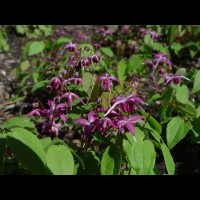 Epimedium x youngianum 'Ruby Tuesday'
Epimedium x youngianum 'Ruby Tuesday'
***2001 CobblewoodIntroduction***
Small and delicate, it begins to bloom at only 5” tall. After a second and third flush of foliage and flowers, it eventually reaches 14”, making it one of the latest blooming of Epimediums. Its small spring leaflets have a purple cast. Medium-sized flowers are rich, ruby-red with lighter pale rose to white spurs.
 Epimedium x youngianum 'Starlet'
Epimedium x youngianum 'Starlet'
Introduced by Diana Reeck of Collector's Nursery. Charming medium pink/lavender blooms float over a base of medium-sized elongated leaflets, each edge sponged with deep red in spring. Lighter pink to white highlights the backs of the sepals, the edges of the petals, and the tips of the spurs. Wiry red flower stems complement the spring color of the leaflets. A long-blooming, light and airy and very floriferous selection. 6" in bloom, with a second growth flush of colorful foliage to 11". An early bloomer.
 Epimedium x youngianum 'Sudama'
Epimedium x youngianum 'Sudama'
An unusual Japanese cultivar with curious raspberry red, pendent flowers borne below the unfurling leaves. The sepals never open, leaving the flower as a dark, inflated ellipse with slightly lighter shoulders. Large spring leaves flush with a soft red edge that eventually fades to a thin line. Blooms late, on 15” stems.
 Epimedium x youngianum 'Tamabotan'
Epimedium x youngianum 'Tamabotan'
(Synonyms: We Du Special, Special Pink and ‘Pink Ruffles’)
Medium-sized silvery lavender flowers flushed with light lavender hover above new foliage tinted purple with a unique turquoise cast. Petals/inner-sepals similar in size and shape, give the flower a “double” appearance. Small leaflets. 8” in bloom, to 18-20”.
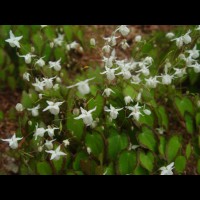 Epimedium x youngianum 'White Cloud'
Epimedium x youngianum 'White Cloud'
***2001 Cobblewood Introduction***
‘White Cloud’ blows the roof off bud count with an astounding number of flower stems per plant. With a few hours of sun each day, it literally yields clouds of small, white flowers on 6-10” stems. Each small spring leaflet sports a pale purple perimeter band. A Darrell Probst (always searching for a higher bud count) hybrid.
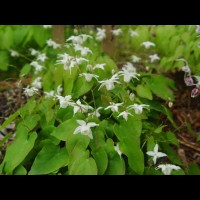 Epimedium x youngianum 'White Star'
Epimedium x youngianum 'White Star'
***2000 Cobblewood Introduction***
A spontaneous open pollinated seedling found in the Asian Collections at the U.S. National Arboretum. This floriferous clone bears small, white flowers with spurs equal in length to the inner-sepals. The small thick leaflets remain evergreen in USDA Zone 7 and farther south, semi-evergreen elsewhere. Delightful at 5" tall in bloom, eventually growing to 8". Its exceptional foliage makes it a nice edging plant.
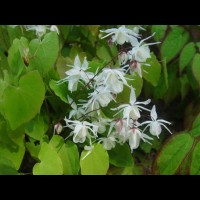 Epimedium x youngianum 'Yenomoto'
Epimedium x youngianum 'Yenomoto'
The pristine white flowers of this Japanese clone are distinguished by their long, straight, down-facing inner-sepals and spurs. Each flower is held by four silvery-pink outer sepals that give a distinctly bridal feel to the plant. Long blooming with Small leaflets. 8" in bloom, growing to 12" high.
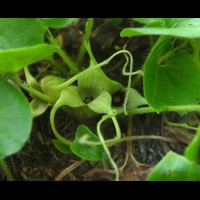 Asarum caudatum forma alba
Asarum caudatum forma alba
A "white” flowered form of this lovely West Coast native ginger. It thrives in partial shade, and moist, humus-rich soil, forming attractive colonies of large, lustrous, dark green, heart-shaped leaves 4” tall. Curious, creamy green flowers, each with three long tails, appear at the base of the plant in spring. This form is not com
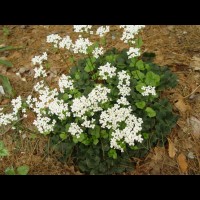 Cardamine trifolia "Japanese Cultivar"
Cardamine trifolia "Japanese Cultivar"
Beautiful, very low growing: 2-3” high, dense and tidy shade ground cover. Purchased in a Japanese garden shop by Barry Yinger with a name he could never find reference to. He believes it is a special selection. It is too nice of a garden plant to let that keep us from offering it.
Clouds of white cruciferous blooms hover 8-10” above the foliage on naked stems in mid-May. Deep evergreen trifoliate leaves with velvety purple undersides. Spreads slowly over time via 2” herbaceous rhizomes. Does best in bright to deep shade, in evenly moist, humus-rich soils. A favorite of mine.
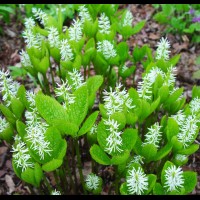 Chloranthus japonicus
Chloranthus japonicus
Native to Japan and Korea. Easy to grow shade perennial with four corrugated leaves surrounding a white, bottle brush-like inflorescence. Bold, cup-shaped foliage lends interesting texture to the shade garden. Forms a small clump over time. 12-15” high.
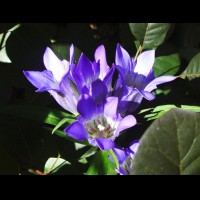 Gentiana scabra
Gentiana scabra
An easy to grow, robust species for sun or partial shade (more shade where summers are hot). Tolerates a wide variety of soil conditions; blooms July-October. Native to northern Asia and Japan, this variable species sports erect, leafy erect stems 8 -15” high. Violet-blue, tubular upright facing flowers with 4 pointed corolla lobes. These plants are selected seedlings.
 Gentiana x 'True Blue'
Gentiana x 'True Blue'
***2008 Cobblewood Introduction***
Forms a well-branched, upright, robust column 24-36" high, by 12-18" wide, with lance-shaped leaves and 2” tubular caerulean blue flowers from midsummer-early fall. Best in part shade to full sun (in the north).
Plant in well-drained sandy loam/loamy soils with consistent moisture. A Darrell Probst hybrid. Propagation prohibited.
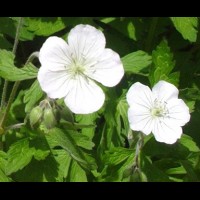 Geranium maculatum 'Cobblewood Ghost'
Geranium maculatum 'Cobblewood Ghost'
This dainty woodland native bears white 1.5” blooms for 6-7 weeks in May-early June. Native to the eastern U.S. and Canada. Grows best in part shade to full sun. If planted in some sun, the dark green palmate leaves turn brilliant scarlet in fall. 2’ high by 18” wide. Darrell found this clone (far superior to the more commonly offered ‘Hazel Gallagher’) growing wild in central Massachusetts. Will naturalize in the garden from seed.
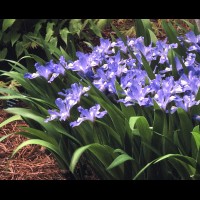 Iris cristata 'Edgar Anderson'
Iris cristata 'Edgar Anderson'
Large flower form with periwinkle blue falls that darken below the diffused signal ring. Wide white signals bordered in a dark blue ring. 6.5” in bloom with two 2-1/4” flowers per stem. This selection has outstanding vigor, good substance, spreads quickly. An early bloomer.
A beautiful blue form of Iris cristata from Iris breeders Marty Shafer and Jan Sacks of Joe Pye Weeds Garden in Carlisle, MA. The blue and white crest saturates the flower with color. 4.5" tall in bloom. Vigorous spreader.
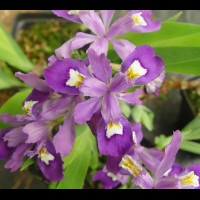 Iris cristata 'Merle's Ruby'
Iris cristata 'Merle's Ruby'
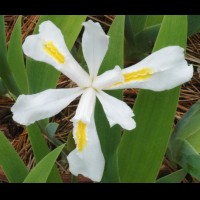 Iris cristata 'Montrose White'
Iris cristata 'Montrose White'
***2010 Joe Pye Weed's Garden Introduction***
A showy, strong-growing, clean white form, originally from Nancy Goodwin at Montrose Nursery. Its large, nearly 3” diameter flowers are unique among the “albas”. Grows to 6” tall. Spreads 2-4" per year. (Photo courtesy of Jan Sacks)
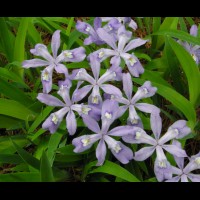 Iris cristata 'Sam's Mini'
Iris cristata 'Sam's Mini'
***2006 Joe Pye Weed's Garden Introduction***
Another treasure from Sam Norris, collected by Sam in Olive Hill, Kentucky. A “mini” at only 3-1/2” in height, it has similarly small flowers and compact foliage. Over several years, it forms large dense mats with many bloom stalks. The flowers have a soft appearance and are medium blue-violet with white signals, yellow and white crests with a slightly darker blue-violet halo (Photo courtesy of Jan Sacks)
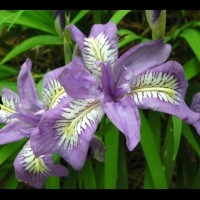 Iris gracilipes
Iris gracilipes
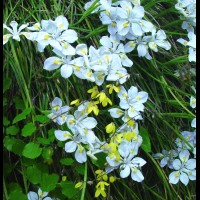 Iris dabashanensis
Iris dabashanensis
(formerly sold under the name Iris henryi)
A newly named Iris species collected by Darrell Probst in N.E. Sichuan Province. Belongs to the same Chinensis section of the genus Iris as I. koreana and odaesanensis, but is very different. Best in bright shade/half-sun and in rock gardens. Forms a 12” by 2’ clump of evergreen, grassy foliage 1/8” wide. In mid-spring, numerous 6” stems emerge, each bearing two 1”+ palest lavender Iris flowers with a small, yellow signal. Pictured here in combination with Epimedium platypetalum.
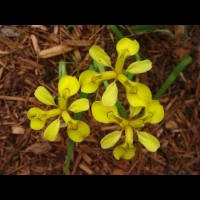 Iris koreana
Iris koreana
During his last stop in S. Korea in 1997, Darrell crawled up a nearly dry stream bed beneath dense scrub for this treasure. It produces glowing yellow 1-1/2” flowers, each with a narrow brown halo surrounding the signal. Flowers are held on 6” stems above the expanding leaves. Semi-evergreen to 12”. Best with 3-4 hours of sun here, it grows in bright shade and perhaps even full sun. Produces a substantial, grassy-leaved clump after several years.
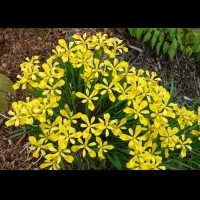 Iris koreana 'Firefly Shuffle'
Iris koreana 'Firefly Shuffle'
***2010 Cobblewood Introduction***
A very floriferous clone of this Asian species iris, and a good grower. Mid May is heralded with the annual explosion of sunny, bright lemon yellow blossoms covering the plant. Great for the rock garden. Best in bright shade or a few hours of direct sun, it forms a grassy-leaved clump that slowly spreads into a “patch”. Semi-evergreen.
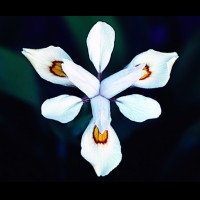 Iris odaesanensis
Iris odaesanensis
Pristine white flowers with a yellow signal edged in a thin, brown halo. Two flowers, each nearly 2” in diameter, are borne atop 8” stems in late May. Semi-evergreen leaves expand after bloom to reach 12” long, 1/2” wide, forming dense clumps of arching foliage. Prefers a little more sun than Epimediums. This clone was originally collected on Odaesan in Korea by Darrell Probst in 1997.
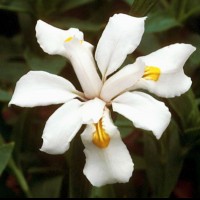 Iris odaesanensis Chuwangsan #3
Iris odaesanensis Chuwangsan #3
I. odaesanensis was previously known to exist only on the top of Odae-san (san = mountain). To the surprise of his Korean host from Chollipo Arboretum, Darrell found a few pockets of it growing on a wooded rocky ledge on Chuwangsan, 100 miles south of Odaesan. He collected three unique clones.
The flowers of this vigorous grower lack the typical brown halo surrounding the signal. It also seems to be less tasty to the local slugs. Semi-evergreen.
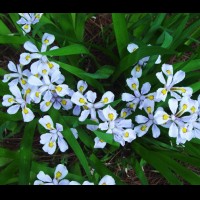 Iris odaesanensis 'Ice Whisper'
Iris odaesanensis 'Ice Whisper'
Semi-evergreen leaves grow to 12" after bloom, forming dense clumps of arching foliage. Half to full sun exposure.
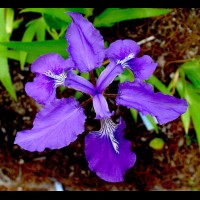 Iris tectorum 'Slippery Slope'
Iris tectorum 'Slippery Slope'
***2010 Cobblewood Introduction***
Darrell has failed endless times growing the Japanese roof iris in our climate. The flower buds die over winter, starting a rot that eventually kills the plant. He collected this much hardier clone at a high elevation in the Dabashan region of southern Shaanxi Province, China. Here they were pulled up and over the icy mountain by a coal truck in Nov. 2000, hence the cultivar name.
This clone thrives in half sun on an exposed stony ridge in my garden. Best with sharp drainage in light shade/part sun. Large 4” violet blossoms emerge in late spring from 2’ × 2’ bright green foliage fans, giving a tropical appearance to an otherwise New England perennial garden. Spreads slowly, 2-5". per year, by fleshy rhizomes to form a massive clump over time, so give it some elbow room! Needs division every 3-4 years for maximum vigor.
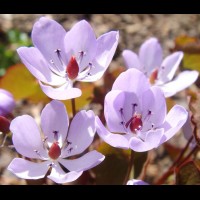 Jeffersonia dubia "Dark Centers"
Jeffersonia dubia "Dark Centers"
Name change to: Plagiorhegma dubia "Dark Centers", but I can't bring myself to call it that.
This plant provides a pop of welcome early spring color as soon as the ground thaws. New leaflets emerge a rusty brown color to contrast with the periwinkle blue/lavender petals. A cranberry colored ovary and dark purple/black anthers add to its charm. These plants are seedlings from plants Darrell collected in the wild in Korea.
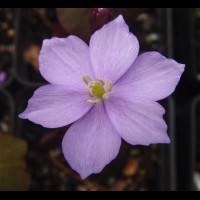 Jeffersonia dubia "Putnam's Blue"
Jeffersonia dubia "Putnam's Blue"
The Asian Twinleaf is a choice perennial that any “real” garden can’t be without, and the more, the better. It blooms very early in spring, usually starting a couple of weeks before the epimediums. Its flowers fade quickly if the suddenly weather heats up. Flowers of "Putnam's Blue" open a deep blue-lavender, and fade with age. The blossoms seemingly float above the rounded, wavy-edged, almost waterlily-like leaves.
Plants bloom at about 4-6” tall, each leaf expanding to 2-3” or so across eventually forming a dense clump 8-10” tall. This selection has the same rusty-red new growth in spring, but is deeper blue-lavender in bloom than ‘Dark Centers’ with a green ovary and longer, fatter, sculpted petals. These are seed grown as Jeffersonia defies division. It originally came from Bob Putnam’s nursery via Jim Jones.
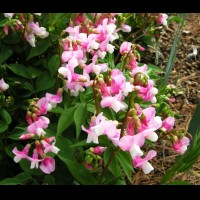 Lathyrus vernus 'Albo-roseus'
Lathyrus vernus 'Albo-roseus'
Another tough, long-lived perennial native to Europe for either full sun or partial shade. It tolerates many situations and is a good foliage plant throughout the season. Showy racemes of bi-colored pink and white pea-like flowers in earliest spring, on neat clumps to 18”. Leaves pinnately compound. Easy to grow and long-lived. (Photo by Jan Sacks)
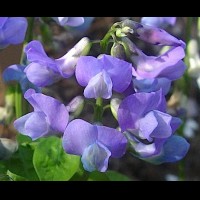 Lathyrus vernus 'Katrink Hull'
Lathyrus vernus 'Katrink Hull'
Blue-flowered Perennial Sweet Pea
***2011 Cobblewood Introduction***
Selected as the best from a few “blue flowered” seedlings of the perennial sweet pea in the former garden of our late friend and accomplished rock gardener Katrink Hull. Flowers are an amazing caerulean blue mixed with shades of violet blue. Vigorous growing and free flowering. Best in bright shade or a few hours of sunlight per day. Handsome green pinnate foliage (typical of the pea family) on a 12-15" high plant in summer/fall. Blooms along with the earliest Epimediums.
 Phlox stolonifera 'Wister Pink'
Phlox stolonifera 'Wister Pink'
A dusky pink form of this easy to grow native plant, not commonly available in the trade. The rounded leaves form a thick groundcover 2-3" high, above which the large flowers bloom in mid-May in Massachusetts. 6-8" tall in bloom. Spreads by 6-8" runners. Semi-evergreen.
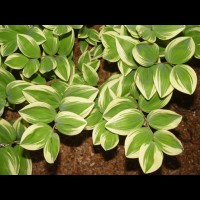 Polygonatum odoratum 'Carlisle'
Polygonatum odoratum 'Carlisle'
A brilliantly variegated Japanese Solomon Seal with much wider white margins than are typical, and a slightly shorter stature-18-20”. The stems also have a slight red tint. Spreads slowly, by 2-5" rhizomes, making an excellent, showy groundcover. Great for brightening up dark spaces in the shade garden.
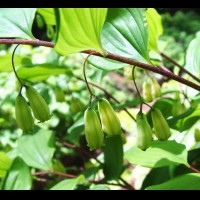 Polygonatum omeiense
Polygonatum omeiense
A charming Asian Solomon’s Seal from Sichuan Province, China. This attractive, low groundcover features fat, greenish-white, capsule-shaped blossoms in pairs in mid-early June in Massachusetts. Its arching stems are speckled with purple-brown and hold the undulating leaflets, giving textural interest to the garden. 12 to 15” high. Spreading rhizomes grow 2-3” per year.
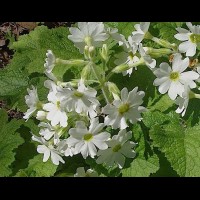 Primula kisoana forma alba
Primula kisoana forma alba
The white-flowered form of this spreading Japanese woodland primrose. Downy, scalloped light green foliage is very different from other Primulas. Great as a low ground cover planted at the base taller woodland plants. Clusters of white flowers in mid-May. Prefers evenly moist, humus-rich soils. 4-6” high. Spreads by rhizomes of varying length to form extensive, thick colonies over time.
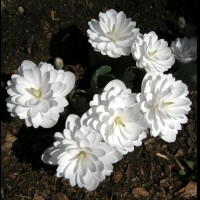 Sanguinaria canadensis 'Multiplex'
Sanguinaria canadensis 'Multiplex'
Elegant double form of the native bloodroot. The full, white, multi-petaled flowers and glaucous foliage resembles a pool of waterlilies in the spring garden. Spreads by fleshy underground rhizomes to form large colonies over time. Best in light shade. This double-flowered form blooms for a considerably longer period than the more fleeting, fertile, single-flowered forms. (Photo by Jan Sacks, Joe Pye Weed's Garden)
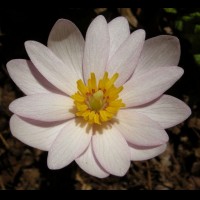 Sanguinaria canadensis 'Venus'
Sanguinaria canadensis 'Venus'
In earliest spring, the buds of this native shade-loving Bloodroot variant emerge a deep pink. The showy wide-petaled flowers open light pink, and fade to shell pink. Dark pink stems on both leaves and flowers. The reverse sides of the petals remain a darker pink, repeatedly displaying their rich pink blush when they close each evening. Gradually spreads by thick fleshy rhizomes, 2-6" per year, to form a large colony over time.
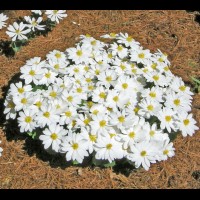 Sanguinaria canadensis 'Snow Cone'
Sanguinaria canadensis 'Snow Cone'
***2016 Joe Pye Weed's Garden Introduction***
A long awaited superior form selected from Sanguinaria canadensis ‘Tennessee Form’ seedlings. Each clean, white flower has 18 to 25 petals, and is 3+ inches across. A strong grower, it quickly forms a dense, prolifically flowered clump, spreading by thick, fleshy rhizomes, 2-6" per year. Blooms for a longer time than the fleeting native form. 5-5.5” tall in bloom, to 12”. It is fertile and produces seed. This clone also seems to holds its foliage longer than the other types before going dormant in summer. A true beacon of white in the early spring garden.
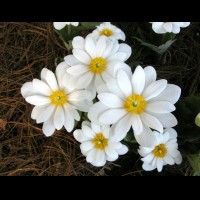 Sanguinaria canadensis "Tennesee Form"
Sanguinaria canadensis "Tennesee Form"
Our native Bloodroot flowers sport a single row of eight petals, whereas this form from Tennessee has at least two rows for a total of sixteen. The flowers, some reaching 3-1/4” across, cover the foliage. The interior row of petals is slightly narrower and 1/4” shorter creating a showy semi-double flower. 5-6” tall in bloom with deeply incised leaves. To 12” Spreads by thick, fleshy rhizomes, that grow 2-4" long annually. (Photos by Jan Sacks, Joe Pye Weed's Garden)
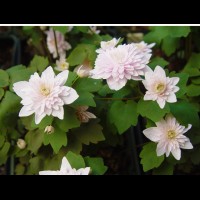 Thalictrum (formerly Anemonella) thalictroides 'Cameo'
Thalictrum (formerly Anemonella) thalictroides 'Cameo'
This easy-to-grow, ephemeral spring Rue Anemone produces sterile blooms over a long period in spring. Delicate, double flowers of the palest pink top the short 5-6” plants. Typically goes dormant in early summer, so mark the space it occupies, so you don’t crowd it out with other additions to the garden in its absence. Site in well-drained soils in bright shade for best results.
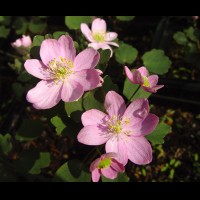 Thalictrum (formerly Anemonella) thalictroides 'Pink Pearl'
Thalictrum (formerly Anemonella) thalictroides 'Pink Pearl'
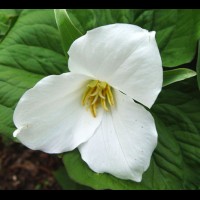 Trillium grandiflorum "Trina's Wisconsin Clone"
Trillium grandiflorum "Trina's Wisconsin Clone"
Trillium grandiflorum “Trina’s Wisconsin Clone”
***2017 Cobblewood™ Introduction***
A native trillium that I have grown for years. I was encouraged by plantsman Mark McDonough to offer it for its full rounded flower form. This lime-loving species is easy to grow forming large, blowsy, floriferous clumps. One of the most coveted plants at my Open Nursery Days. Given to me by my gardening friend Trina Van Cura. She brought it with her when she moved from Wisconsin. Reaches 15 to 18”.
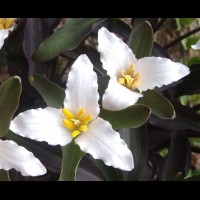 Trillium pusillum 'Roadrunner'
Trillium pusillum 'Roadrunner'
***2007 Joe Pye Weed's Garden Introduction***
Trilliums are notoriously slow to propagate. While this diminuitive species propagates faster than most, this clone grows particularly rapidly, making a substantial, floriferous clump in just a few years. Trillium pusillum is native to S.E. United States west to Oklahoma. New spring leaves emerge dark purple, almost black, and remain so as the 1-1/2” white, tri-petaled flowers open. It begins bloom at 4", with the foliage eventually reaching 12" tall. Foliage usually goes dormant and disappears by summer's end. Each petal has a rosy reverse. Foliage matures to green as the flowers blush to pink as they age.
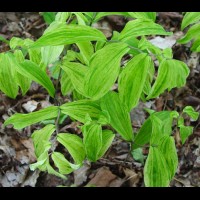 Uvularia sessilifolia 'Blizzard'
Uvularia sessilifolia 'Blizzard'
An East Coast native, this unique Bellwort was discovered in the wild by Darrell Probst. Reaching 6-8” in height, it spreads slowly by 2-3” rhizomes. Its green leaves are brightened by irregular striped variegation that begins as white, and ages to cream. The stems terminate in a small, yellow, bell-shaped flower in spring.
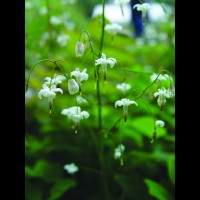 Vancouveria hexandra
Vancouveria hexandra
A west coast native, and also a later-blooming relative to Epimedium. This fine-textured, low-growing groundcover sports leaflets reminiscent of “duck’s feet” to 6” high, with flower stems to 15”. Blooms about a month later than do Epimediums, producing numerous small, pendulous white flowers, similar to those of Epimedium, but with six flower parts instead of four. Very drought tolerant and an excellent ground cover for deep shade. Spreads vigorously by thin, 6-10" underground rhizomes. Rumored not to thrive in the deep south.